Text
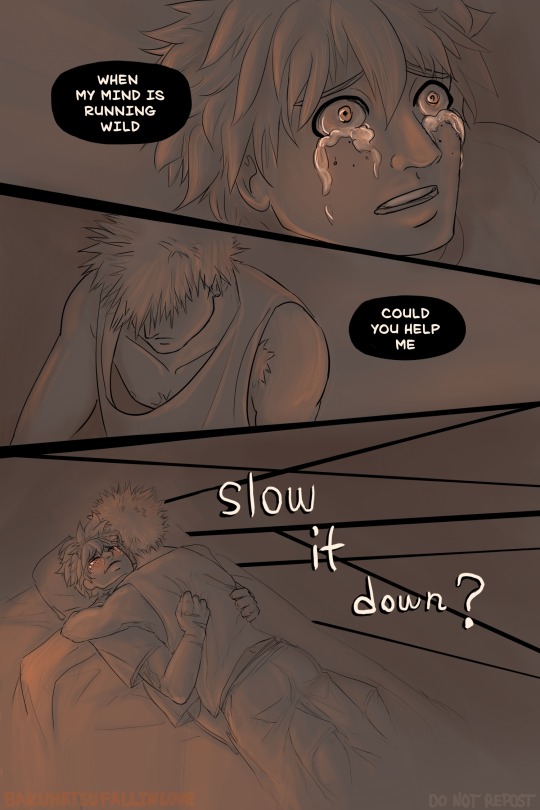
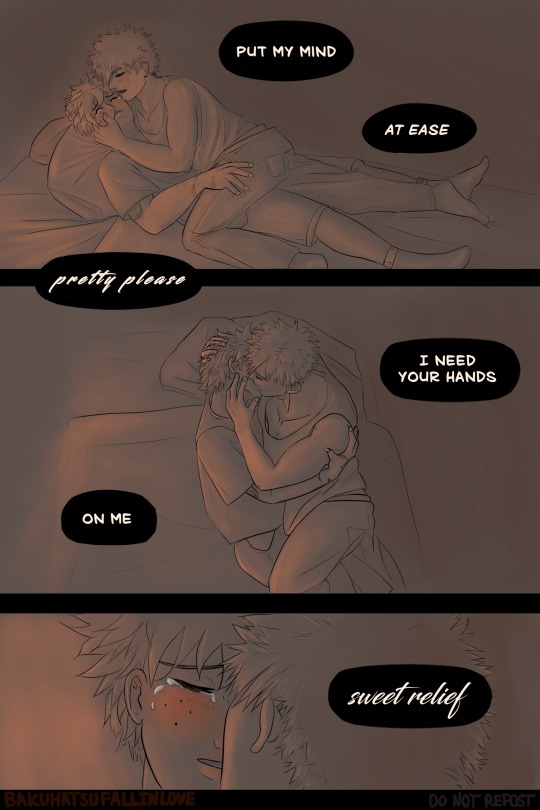

Inspired by @siflshonen's fic Faster, specifically chapter 3.
"When they finally break, there is almost no sunlight in the room, but Kacchan is smiling gently and glowing like he did in the hospital.
He really does glow, thinks Izuku. Or at least he does to me."
Happy birthday, Kacchan. Kiss that damn nerd to your heart's content. You both need it.
(lyrics from Pretty Please by Dua Lipa)
88 notes
·
View notes
Text



Inspired by @siflshonen's fic Faster, specifically chapter 3.
"When they finally break, there is almost no sunlight in the room, but Kacchan is smiling gently and glowing like he did in the hospital.
He really does glow, thinks Izuku. Or at least he does to me."
Happy birthday, Kacchan. Kiss that damn nerd to your heart's content. You both need it.
(lyrics from Pretty Please by Dua Lipa)
#bkdk#dkbk#bakuhatsu art#sifl ripped my heart out with that fic and then put it back together#the idea of Kacchan's touch being a balm to Izuku's soul#after everything they've been through#he wants but it's so hard to have#and Kacchan gives it anyway#holds him through it all#intimacy in the realest sense
88 notes
·
View notes
Note
I've been wanting an excuse to talk about formality a little more in-depth, and Monoma is a delightful little maniac that I have written a little about before, so I'm tapping in.
First let me say that, in my opinion, Monoma speaking informally to Class 1-A is not rude on its own, it is rude because his intentions are clearly to be rude. Especially among male teenagers, casual language towards peers is not always rude in the “I am currently insulting you” sense, it can also reflect a “roughness” in their characterization, conveying a “regular dude” masculinity. I could be missing something here, but for example, I can’t think of a single time when Kaminari or Sero use formal speech with a peer.
Informality among peers is often a gesture of friendliness and reciprocation demonstrates group cohesion. Kirishima speaks casual macho man Japanese with all of his classmates from his earliest appearances, but he is accurately perceived as friendly and sincere.
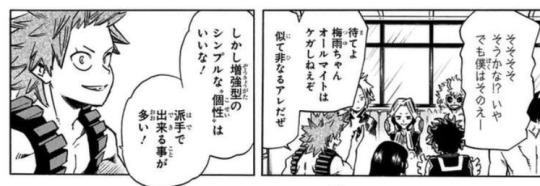

Chapter 13
In fact, during the bus ride at the beginning of the USJ arc, Class 1-A have only known each other for a short while, yet everyone speaks casual Japanese, with one exception: Yaoyorozu. She is characterized as a very high class, dignified, intelligent girl, and she speaks formally all the time. You could argue that Yaoyorozu is, in a sense, rejecting the friendliness of her peers by responding formally. Perhaps not consciously; obviously she disapproves of the conversation, but we also know that she is often anxious and unsure how to make friends. That awkwardness and delicacy of speech are fundamentally part of her characterization.
Formality, or lack thereof, is not always just about the listener, often it is also about what kind of person the speaker wants to be seen as. I know some middle-aged women use formal language with their own family, because they want to maintain a sense of dignity and refinement even in front of their loved ones. It is important to their own self-image for them to conduct themselves with grace.
The other side of that spectrum is being unrefined, having swagger, acting rough and tumble, talking like you know what’s what. I haven’t brought up gender or social class in relation to formal/casual speech because it is complicated to say the least, but keep in mind that especially in media, the cultural images the character plays into are just as important to consider as their relationship to the person they are talking to.
Now then, let’s talk about Monoma Neito, Douchebag Extraordinaire.
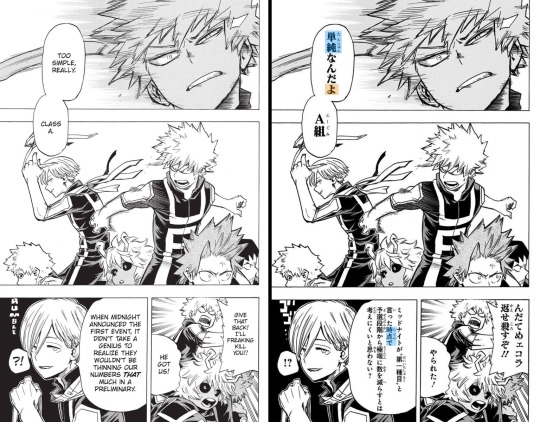
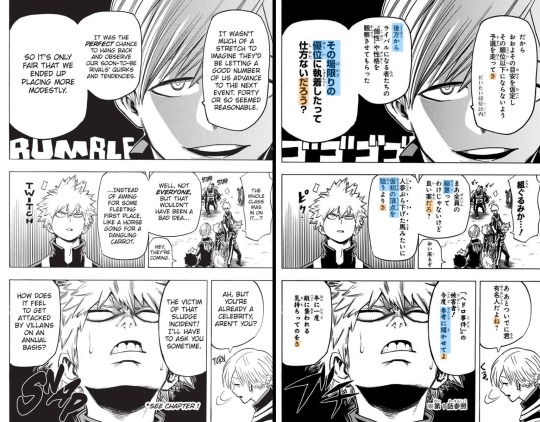
Chapter 28
I’ve highlighted some things I think stick out in his way of speaking. There are two main things to note:
Word Choice: Monoma chooses more complex, specific, or erudite-sounding synonyms of common words and turns of phrase. Highlighted in blue.
“Friendly,” charismatic language: Monoma is speaking informal Japanese, and he uses a few specific particles to inflect his sentences: daro(u), yo, ne, and sa. These create a conversational, almost friendly tone. Highlighted in orange.
These choices serve two purposes: to talk down to 1-A, showing contempt especially in the condescending “Oh, can you keep up? Do you need a dictionary?” way. And, to make sure everyone still knows he has class.
Examples of word choices:
"Simple” - 単純 (tanjun) rather than 簡単 (kantan)
The uses for tanjun and kantan overlap, but while kantan can be used to describe something that is easy to do, tanjun is used to describe people as simple-minded. This makes it clear that the subject of Monoma’s sentence is not the fact that he has gained the advantage over 1-A, it is 1-A themselves.
“When” - 時点で (jiten de) rather than 時に (toki ni)
Jiten de seems more intense or dramatic compared to toki ni, a common phrase. This reads like “From the very moment Midnight announced the first event.” Using “when” softens the sentence and affords Monoma chill, and he makes it very clear that he has none.
“Behind” - 後方から (kouhou kara) rather than 後ろで (ushiro de)
Kouhou kara reads as more conceptual, maybe even a little military-ish, like “the enemy approached from the rear.” Ushiro de is the every-day way to say "behind."
“Temporary advantage” - その場限りの優位 (sono bakagiri no yuui) rather than 仮の優位 (kari no yuui) or 一時的優位 (ichijiteki yuui)
An uncommon phrase, which can be translated as “ad hoc advantage,” and he chooses it over the common word for temporary or even a simple phrase used to mean short-lived.
“Consensus” - 総意 (soui) rather than 同意する (doui suru)
This is like the difference between someone saying, “We hardly came to what you could call a consensus” instead of “I mean, not everyone agreed.”
“Aiming for some fleeting first place” - 仮初の頂点を狙う (karisome no chouten wo nerau)
Karisome means temporary just like sono bakagiri, but rather than repeat himself, Monoma chooses a new word to show off his vocabulary. Karisome carries the secondary meaning of trifling or trivial (hence the English translation’s use of “fleeting”), so this choice is even more insulting.
“Tell me for future reference” – 参考に聞かせてよ (sankou ni kikasete yo)
This one just kills me. It's so annoyingly phrased. He could have said, さあ、興味があるけど (“You know, I’m curious/interested”) or even 聞かせてくれね (“Tell me about it,” in a do-me-a-favor way), but no, he issues a light, casual command for "reference."
As mentioned, casual speech from men can exude a “tough guy” vibe, and it often brings to mind working-class or delinquent social status with its unique flavor of masculinity. Katsuki intentionally plays into this image with his speech patterns.
Monoma explicitly avoids it.
He is meticulously crafting a social image here. He isn’t some empty-headed ruffian, as Katsuki is typically perceived. Monoma wants to be seen as brilliant, graceful, calculating, and charming.
It isn’t any one thing that does this, it is all of these little things together. The big thing is the actual content of his monologue at Katsuki, right? The way he is obviously taunting him. But all of these little details in his speech pattern intensify and add specificity to his characterization.
I glanced at a few of his other appearances, and I got the sense that this is one of the more extreme examples in the way that it is jam-packed with off-kilter word choices, because even 2-3 sophisticated synonyms wouldn't be that weird. Horikoshi has mentioned in interviews that he tries to make character entrances memorable, so Monoma’s behavior is turned up to eleven to give the reader an immediate sense of who he is and how he acts.
In short, Monoma talks like a teenager in debate club who studied a thesaurus to make himself look smarter than everyone else. Some of the fancy words he chooses actually use kanji that you learn in middle school, and this is their first term in high school, so he's just whipping them out right away.
Monoma is a raging edgelord just like Katsuki, but in the most opposite way possible, and it is so, so great.
i was wondering if you could go more in depth about monoma's way of taunting class 1a? i've seen the class 1b speech style but i was wondering if theres any cultural context that makes his manner especially strange, especially if he's using informal language with people he hasn't gotten close to. (i've seen some others mention that he talks in a very complex manner in japanese, as well as others saying that he speaks very intensity?) thank you!
I'm gonna be real, I don't know how to answer your question. To use informal speech with people you're not close to is pretty much definitionally disrespectful in Japanese, so it makes sense Monoma would do that. It's something I would also expect from another anime character like him. Perhaps this "complex manner/intensity" you're hearing about is a reference to how...dramatic and megalomaniacal he sounds? The dub isn't terrible at capture that vibe lol. In any case, there isn't anything that immediately sticks out about his manner of speech to me, but I haven't particularly paid close attention beyond what I've vaguely heard at times.
#meta#translations#Monoma is such a smug little tryhard#it's hilarious#I commandeered pika's ask out of passion#can't fight my love of the game ya know#the game being linguistics meta#anyway hope this helps anon!
113 notes
·
View notes
Text
U.A. High School Field Trip Around Japan: Day 7 Translation
This is the final day of Shonen Jump’s special commemoration of My Hero Academia reaching one hundred million copies worldwide, which is being rolled out daily across one-week in each prefecture’s newspaper.
The schedule:
April 4th, Day 1: Hokkaidō & Tōhōku regions
April 5th, Day 2: Kantō region
April 6th, Day 3: Chūbu region
April 7th, Day 4: Kansai region
April 8th, Day 5: Chūgoku & Shikoku regions
April 9th, Day 6: Kyūshū & Okinawa regions
April 10th, Day 7: Nationwide release
You can see the illustrations on their website here, where all but today's finale are available for viewing.

Photo credit: twitter user hurayura
Narration: "We traveled all over Japan on our school field trip. On this journey to express our gratitude, we heard many voices. We want to say again to everyone who supports us now -- from the bottom of our hearts, thank you."
Tagline: "One hundred million copies published of the series worldwide! Thank you. It's the power of everyone!"
There are not pronouns in this monologue, so you could read it as being from Izuku, from the entire class, and of course, from Horikoshi-sensei himself.
This has been a wonderful journey. Japan is a beautiful place filled with amazing sights, unique traditions, wonderful food, and a hundred million people, each different but each part of the whole. I hope you enjoyed my translations and got to learn some really cool things through this series we all love.
Thanks for joining the field trip. <3
56 notes
·
View notes
Text
U.A. High School Field Trip Around Japan: Day 6 Translations
This is Day 6 of Shonen Jump’s special commemoration of My Hero Academia reaching one hundred million copies worldwide, which is being rolled out daily across one-week in each prefecture’s newspaper.
The schedule:
April 4th, Day 1: Hokkaidō & Tōhōku regions
April 5th, Day 2: Kantō region
April 6th, Day 3: Chūbu region
April 7th, Day 4: Kansai region
April 8th, Day 5: Chūgoku & Shikoku regions
April 9th, Day 6: Kyūshū & Okinawa regions
April 10th, Day 7: Nationwide release
You can see the illustrations on their website here, where they are released digitally the day after the newspaper release.
Here we go!
Kyūshū Region
Fukuoka
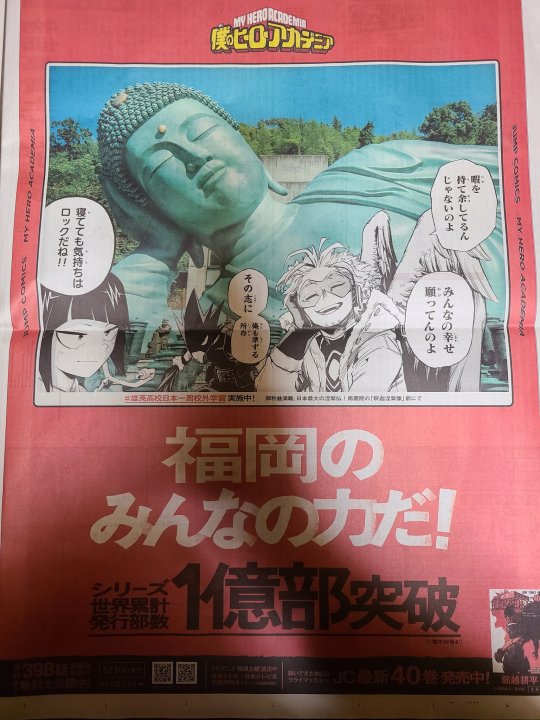
Photo credit: twitter user nika2_prpr
Hawks: "Aren't we all just dying for free time? I just want everyone to be happy, you know."
Tokoyami: "That ambition is what I, too, wish to realize."
Jirou: "He has a rockin' vibe even when sleeping, doesn't he!!"
Nanzo-in Temple is home to one of the largest bronze statues in the world depicting a reclining Buddha, called Shaka Nehan (Nirvana). The statue holds ashes of Buddha and two adherents, which were gifts from Myanmar as thanks for Nanzo-in's donations of medical supplies.
Saga

Photo credit: twitter user yukino_096
Ashido: "The squid are dancing!!"
Tokoyami: "The squid, such speed!"
Aizawa: "For drying a large amount of squid at once, it's a really reasonable method."
Tokoyami: "A magnificent display of stormy turmoil!!!"
This is a fixture at Yobuko Town's morning market which rapidly dries squid by rotating in circles. The Japanese name, ikaguruguru, uses an onomatopoeia for going around in circles so you could call it a "squidy-go-round." Tokoyami uses the Japanese term for the German aesthetic Sturm und Drang. By the way, the term for dried squid, surume, is also used to mean something that grows on you over time. It's one of the most popular snacks in Japan!
Nagasaki
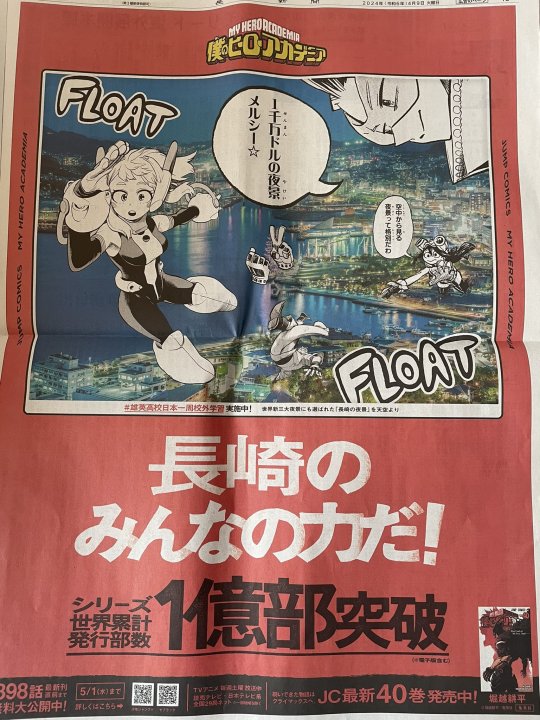
Photo credit: twitter user ssb_uchuubar_
Aoyama: "Merci for the million dollar nightscape~"
Asui: "The night views from the sky are exception!"
Nagasaki is considered to have one of the top three best night skylines in Japan. You can visit Mount Inasa's Observatory to see it for free, but they got something even better!
Kumamoto
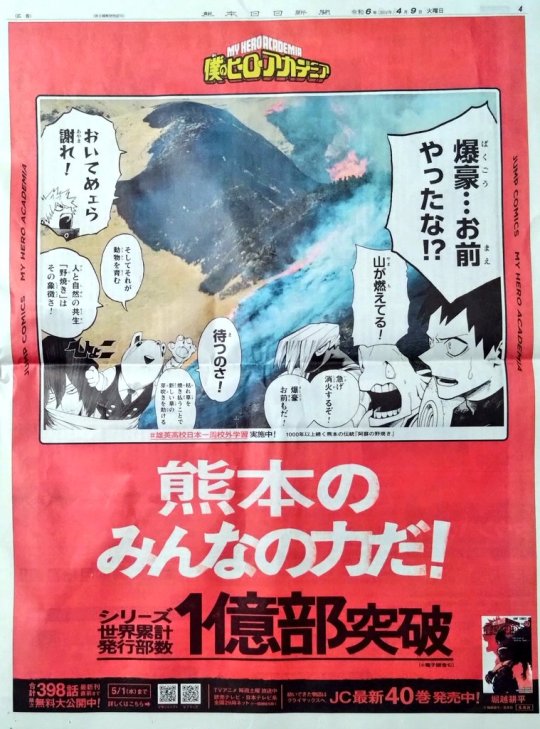
Photo credit: twitter user 18Miyakonbu
Sero: "Bakugou... did you do that!?"
Kouda: "The mountain is burning!"
Shouji: "Quick, put it out! Bakugou, you help too!"
Nedzu: "Hang on! Dry grass being burnt down helps new grass sprout. This nurtures the animals as well. Humans and nature in symbiosis, that's what burning the fields represents!"
Bakugou: "Hey, you bastards, APOLOGIZE!"
The city of Aso lights its mountain on fire every year as part of the Aso Fire Festival, a coordinated effort between farmers to replenish the fertility of their soil. My favorite part is that Katsuki doesn't deny that he blew the mountain up in flames... he's saying, "see, I'm helping, all right!!"
Ōita

Photo credit: twitter user im_mim_966
Kaminari: "Now then, who's getting in!! To soothe your travel weariness!"
Iida: "STOP! Do you want to be boiled alive!? Swimming in the Blood Pond Hell area is prohibited!!"
Kaminari: "So this is a 'bitterness of denied entry' type hell, then! (cry)"
They are trying to bathe in the Blood Pond Hell in Beppu City, where iron oxide and magnesium oxide mix and get pushed to the surface to turn the water blood red. Beppu is known for its Eight Hells, hot springs that are so hot (often greater than 200 degrees Fahrenheit), they are meant for viewing rather than bathing--hence their being called a "hell," not a "hot spring!"
Miyazaki
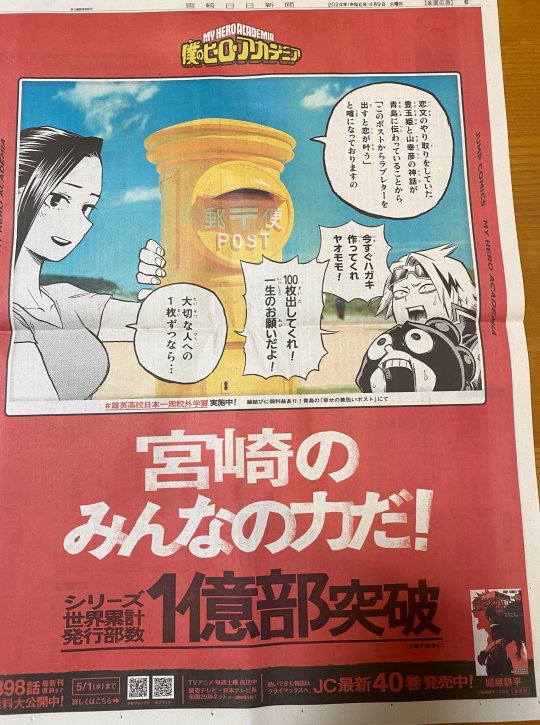
Photo credit: twitter user
Yaoyorozu: "The myth of Princess Toyotama and Yamasachihiko exchanging love letters has been passed down in Aoshima, so there is a legend that if you send a love letter with this postbox, your love will come true."
Kaminari: "Make a postcard for me right now, Yaomomo!"
Mineta: "Make me a hundred! It's my lifelong wish!!"
Yaoyorozu: "It's just one apiece for someone special..."
Postboxes in Japan are red, so this one, called the "Yellow Postbox of Good Luck," is unique. The couple Yaoyorozu mentions are from the Kojiki and Nihon Shiki, which contain some of the earliest written records of Japanese myths and ancient history. Poor Kaminari... he just asked for one!
Kagoshima
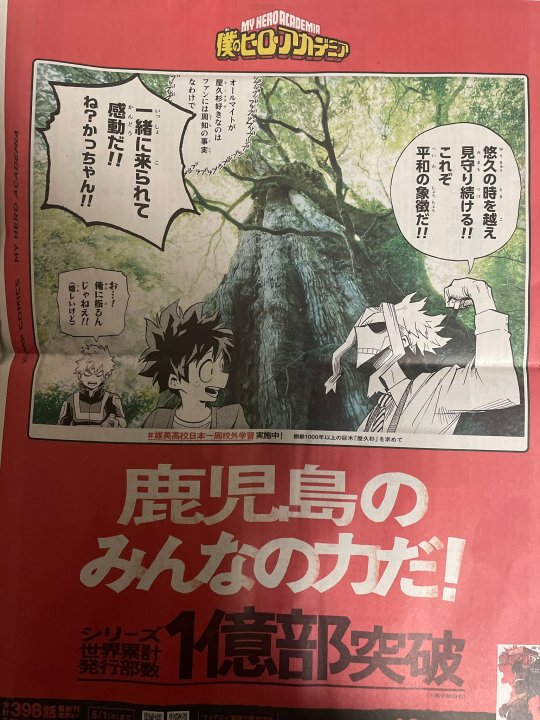
Photo credit: twitter user Door_20200783
All Might: "Continuing to watch over everything for all eternity!! This here, this is the Symbol of Peace!!"
Izuku (mumbling): "It's a well-known fact among fans that All Might loves Yakusugi--"
Izuku (out loud): "I'm thrilled we can all go together!! Right, Kacchan!!?"
Kacchan: "I... Don't drag me into this!! (pleased, though)"
Yakusugi refers to cedars of at least a thousand years old on the island Yakushima, where there are dense coniferous forests with many old-growth trees. The most famous is the Jōmon Sugi, which is estimated to be at least 2,000 years old. Did Kacchan follow them on their tree tour, trying to not be noticed, and Izuku called him out on it~? Or did they companionably embark all together while he put up a grumpy front? Hee!
Okinawa Region
Okinawa

Photo credit: twitter user kkko25
Endeavor: "Shouto, how is it? How is the soba!?"
Todoroki: "Okinawa soba is tasty."
Endeavor: "RIGHT!? SHOUTOOOOOOO!! (joy)"
Todoroki: "Let me eat in peace."
Unlike Todoroki's beloved mainland soba, which is made with buckwheat flour, Okinawa soba is made with wheat flour and is closer to udon noodles.
Aaand that's Day 6, the last release is the grand finale!
30 notes
·
View notes
Text
U.A. High School Field Trip Around Japan: Day 5 Translations
This is Day 5 of Shonen Jump’s special commemoration of My Hero Academia reaching one hundred million copies worldwide, which is being rolled out daily across one-week in each prefecture’s newspaper.
The schedule:
April 4th, Day 1: Hokkaidō & Tōhōku regions
April 5th, Day 2: Kantō region
April 6th, Day 3: Chūbu region
April 7th, Day 4: Kansai region
April 8th, Day 5: Chūgoku & Shikoku regions
April 9th, Day 6: Kyūshū & Okinawa regions
April 10th, Day 7: Nationwide release
You can see the illustrations on their website here, where they are released digitally the day after the newspaper release.
Here we go!
Chūgoku Region
Tottori

Photo credit: twitter user aoao_rice
Ashido: "Ohoo~! Have I got a scoop on a summer fling!?"
All Might: "I have come to rubberneck!! ...not! Let's go, Young Ashido!"
Yaoyorozu: "Since Kaminari-san has overslept again this morning, please be careful as the class representative."
Iida: "Indeed! After all, disturbance of life's daily rhythm is no good."
Narrator: "The class president was simply communicating with administration."
Hakuto Coast is a magnificent beach beside a shrine famous for being the location of the so-called "first love story" wherein the white rabbit (the shrine's namesake, 白兎) played matchmaker for deity Ōkuninushi and princess Yagami after Ōkuninushi advised the rabbit on how to heal its wounds. The shrine specializes in matchmaking charms and the area is considered a "lovers' sanctuary."
Shimane
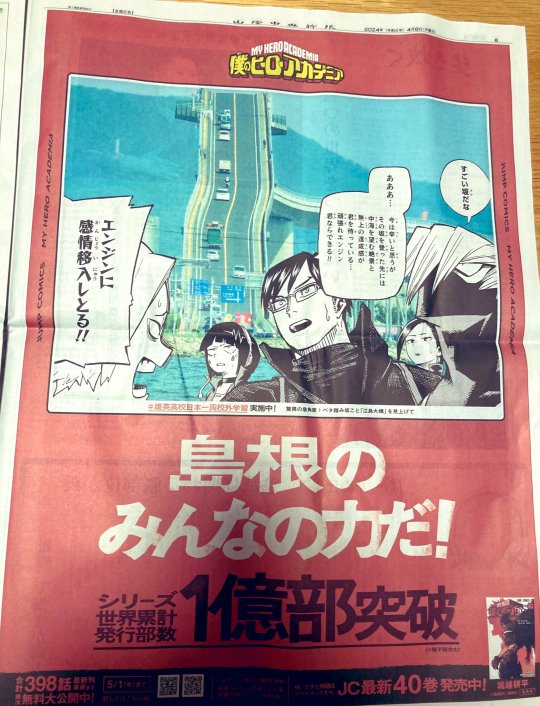
Photo credit: twitter user akamenago
Shouji: "What an incredible slope!"
Iida: "Aah, this will be hard, but at the top of that slope a spectacular view of the ocean and a sense of accomplishment await you... Give it your all, Engine!! You can do this!"
Kaminari: "You're empathizing with the engines!?"
Eshima Ohashi is famous for being photographed in ways that distort its true slope gradient, making it appear insanely steep. It's steep, but not insanely so! I guess Iida identifies with engines.
Okayama

Photo credit: twitter user mayori_nu3sei
Best Jeanist: "Don't give me the cold shoulder. Just say the word and I'll coordinate any number of jeans outfits for us!"
Bakugou: "I WAS JUST PASSING BY, ALL RIGHT!!!"
Kaminari: "Now, now, now..."
Mineta: "C'mon, you can be honest!"
Kojima Jeans Street is a popular tourist destination in Kurashiki City, as it has been dubbed the birthplace of blue jeans in Japan from its first production in the 1960s. Kacchan is in denial--accept your fate and wrap yourself in the weft of rich indigo!!
Hiroshima

Photo credit: twitter user chugokunp_u35
Kaminari: "Hey! Just a minute ago it was on land, now it's under water!?"
Bakugou: "It's just high tide, ain't it!!"
Sero: "Ohh, right, the whole thing with the moon's gravity. So, it sinks once every day?"
Bakugou: "High tide comes twice a day, don't it!! Go back to kindergarten and start over, you pieces of trash!!"
Visiting Itsukushima Shrine, whose torii entrance appears to be floating in the water at high tide and is made out of decay-resistant camphor wood. The shrine buildings themselves are built up so as to not be submerged.
Yamaguchi

Photo credit: twitter user mizyuki_1010
Todoroki: "This is from my father. Please enjoy at your leisure."
Kirishima: "'Ssanks for tha' provisions!!"
Uraraka: "Todoroki-kun, you know, you should say thanks!"
Todoroki: "It's delicious, thank you."
Uraraka: "I meant thank your dad!"
They are eating kawara soba, a unique dish in Yamaguchi which is cooked on a hot curved roof tile.
Shikoku Region
Tokushima

Photo credit: twitter user mgmg_hrak
Kaminari: "Wheeeey..."
Sero: "I'd rather be a dancing idiot than a wheeey idiot!"
Crowd: "Both are idiots, so why, oh why, not dance~!"
Ashido: "Let's go, everyone!! We're all part of this!"
Tokushima's Obon festival includes the Awa dance, wherein huge crowds of people dance in procession over a period of three days. Here's an example! They also often sing a song, dating back to a popular tune from the Edo period, which says both dancers and watchers are idiots, so if you don't dance, it's your loss!
Kagawa
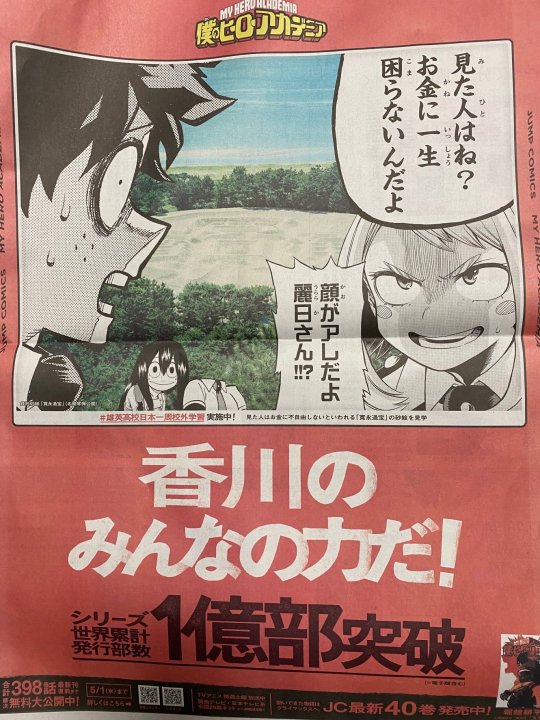
Photo credit: twitter user ZqGuesaki72
Uraraka: "It's anybody who's seen it, right? They won't have money problems for the rest of their life!"
Izuku: "That's a crazy face, Uraraka-san!!?"
The Zenigata Sunae in Kan'onji City is a sand sculpture depicting an old Japanese coin, called kan'ei tsūhō. It was originally constructed in 1633 by the local people to welcome a daimyō. According to legend, anyone who sees the coin will live a long and happy life and never have problems with money.
Ehime

Photo credit: twitter user chiccoinocico
Todoroki: "What's this kind of thing about? Are we, like, BFFs now?"
Kirishima: "You said it, Todoroki! (red-faced)"
This is JR Shimonada Station, an unstaffed train station along the coast which offers beautiful views of the ocean. Kirishima is a sweetiepie, and apparently easily flustered, hehe.
Kōchi
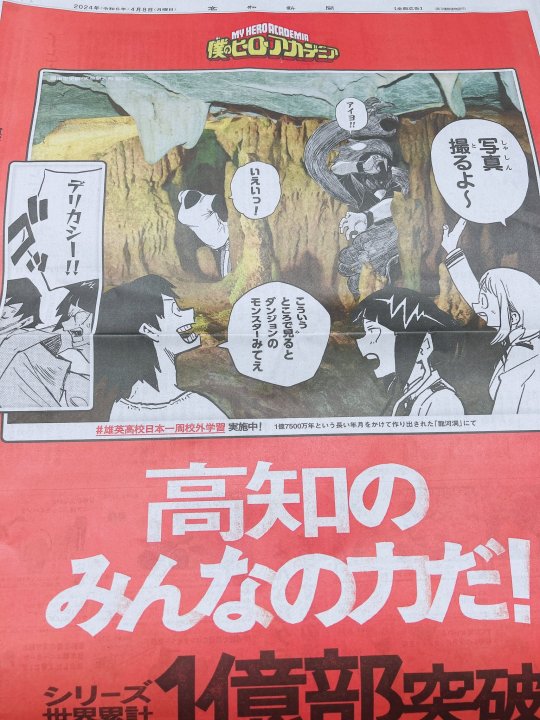
Photo credit: twitter user _baby_hr
Uraraka: "I'm gonna take a picture!"
Dark Shadow: "Aieee!"
Hagakure: "All righty~!"
Sero: "Looking at this kinda thing, it's like seeing a monster in a dungeon."
Jirou: "Use delicacy!!"
Ryūga Cave of Kami City is one of the biggest limestone caves in all of Japan; formed over a period of 175 million years, ancient artifacts from the Yayoi period (~300 BCE to 300 CE) have been found within it. Sero, how could you be so cavalier! Dark Shadow is a good boy!!
That wraps up Day 5, see you for Day 6!
46 notes
·
View notes
Text
U.A. High School Field Trip Around Japan: Day 4 Translations
This is Day 4 of Shonen Jump’s special commemoration of My Hero Academia reaching one hundred million copies worldwide, which is being rolled out daily across one-week in each prefecture’s newspaper.
The schedule:
April 4th, Day 1: Hokkaidō & Tōhōku regions
April 5th, Day 2: Kantō region
April 6th, Day 3: Chūbu region
April 7th, Day 4: Kansai region
April 8th, Day 5: Chūgoku & Shikoku regions
April 9th, Day 6: Kyūshū & Okinawa regions
April 10th, Day 7: Nationwide release
You can see the illustrations on their website here, where they are released digitally the day after the newspaper release.
Here we go!
Kansai Region
Mie

Photo credit: twitter user Hrkn1500
Aoyama: "Sur-pri-se~!"
Sero: "Amazing, Aoyama!"
Satou: "Should we go look for the toilet?"
Nabana no Sato is a flower park situated within the absolutely massive Nagashima Resort. It has lovely blooms all year, and from October to May it claims to host Japan's biggest illumination event, including a 200-meter long light tunnel.
Shiga
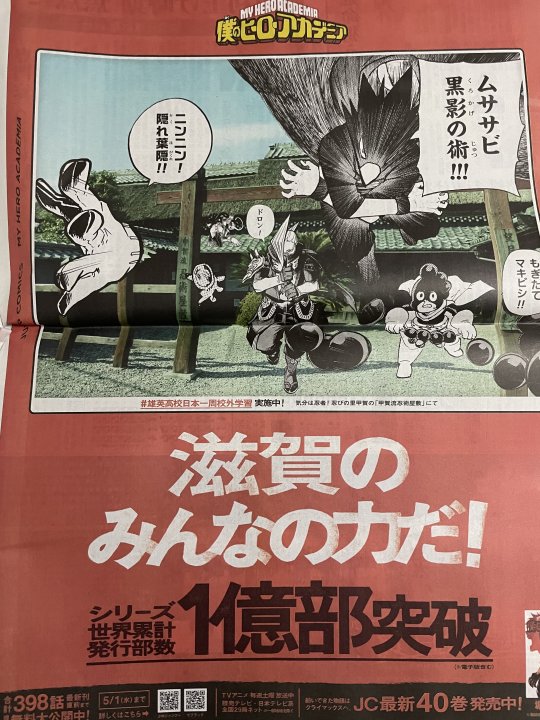
Photo credit: twitter user smile_wk_26
Tokoyami: "Art of the Flying Squirrel Black Shadow!!!"
Mineta: "Imitation Caltrop!!"
Edgeshot: "Abscondance"
Hagakure: "Nin-nin! Hidden Hagakure!!"
They are at the Kōga-ryū Ninjutsu Ninja Village in Kōka city, the birthplace of this school of ninja-arts. I visited the Tōgakure Ninjutsu House in Nagano -- Tōgakure, Iga, and Kōga are considered the three main families of ninjutsu. These kinds of attractions usually have museums dedicated to the style's history and showing off tons of unique historical artifacts, but the main draw is all the activities for visitors to try their hand at being a ninja, shuriken-throwing, wall-climbing, rope-walking, etc.. Hagakure is making a pun, because her surname means "hidden leaves" or "hidden by the leaves" so she is "hidden hidden-leaves." Tokoyami is doing his Black Fallen Angel move, but it's much funnier to make it a giant flying squirrel attack.
Kyōto

Photo credit: twitter user sitatyan_dayo
Ashido: "You can't even see the sky through all the bamboo~!!"
Yaoyorozu: "They say that the growing speed of bamboo is the fastest in the world. I've heard it can grow up to one meter in a single day."
Mineta: "My whole height in a single day... I can't do this!!!
Jirou: "Cheer up."
Label on Mineta: "Mineta Minoru, Height: 1.08 Meters."
Arashiyama Bamboo Forest is a hugely popular tourist spot for its dense, soothing beauty. One meter is equivalent to 3 feet 3 inches; Mineta is just over 3 and a half feet tall.
Ōsaka
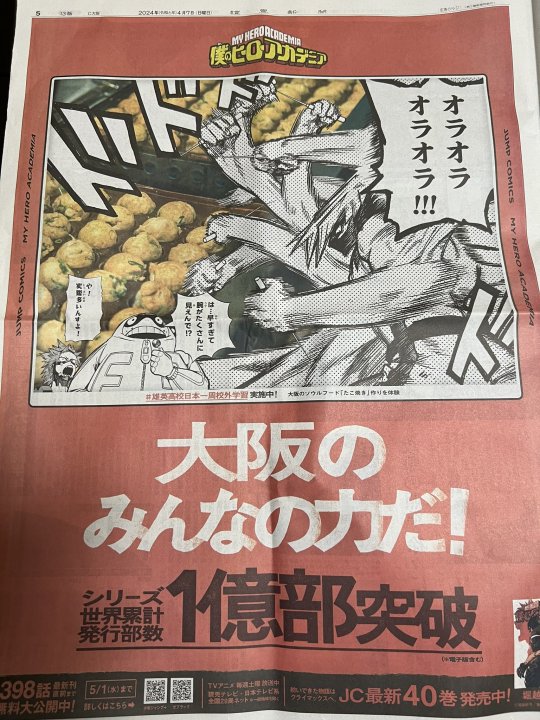
Photo credit: twitter user tomikomha
Shouji: "Hyah hyah hyah hyah!!!"
Fat Gum: "He's... he's moving too fast, I can't even see his arms!"
Kirishima: "No, actually, he's got lots of 'em!"
They are making takoyaki, a famous soul food created in Osaka in 1935. It requires a large griddle with rounded molds, and chefs use two metal rods to rotate the batter rapidly. It's really fun to watch them make it, and most stalls put the griddle up against a full-length window to show it off.
Hyōgo
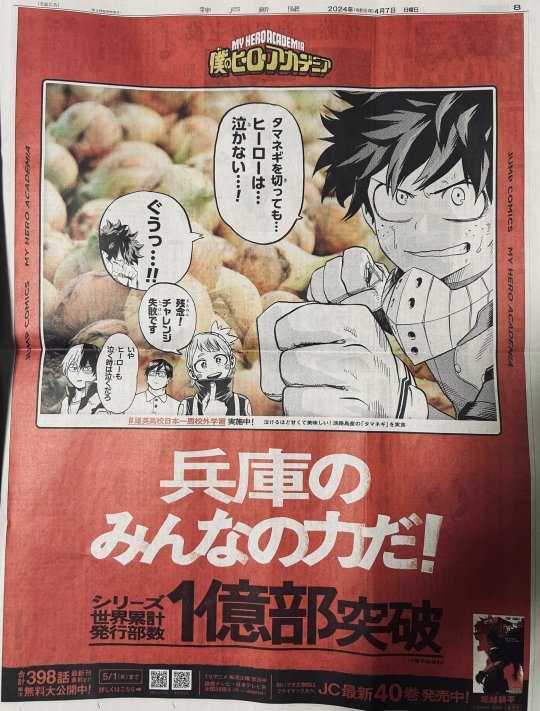
Photo credit: twitter user NZM_101
Izuku: "Even cutting an onion... a hero... doesn't cry! WWUAAAH"
Ochako: "What a shame! Challenge failed."
Shouto: "No, even heroes cry when they have to."
Awaji Island is famous for its onions and produces some of the sweetest onions in the world. They have a spring crop of sweet but slightly spicy onion, and a fall-time harvest that they store and dry to further develop their sweetness. Shouto's line is from chapter 137 when Izuku insists heroes don't cry while crying into his food. What's funny is that sweet onions supposedly produce less of the chemical that produces tears in humans, so maybe Izuku is just being a lil' crybaby, hehe, but we'll give him the benefit of the doubt and assume he's working with a particularly spicy spring harvest.
Nara
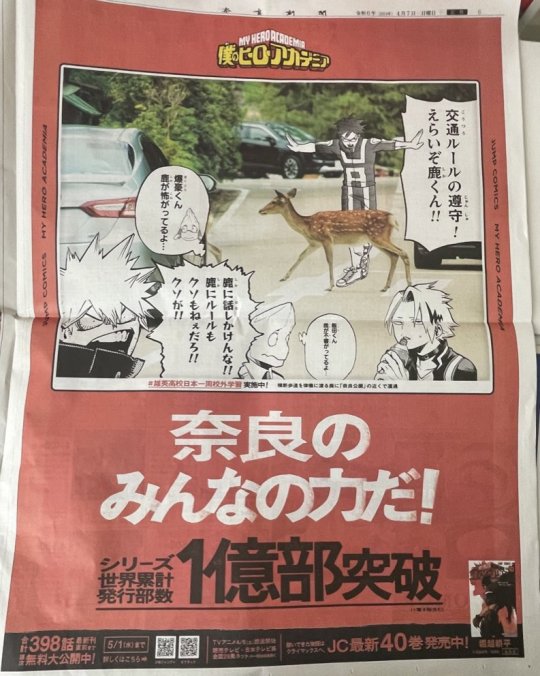
Photo credit: twitter user yukanicoyomo
Iida: "Observance of traffic laws! OUTSTANDING, DEER-KUN!!"
Kouda (thinking): "Iida-kun, you're making the deer suspicious..."
Bakugou: "Don't talk to the deer!! Deer don't give a shit about rules!! Dammit!!""
Kouda (thinking): "Bakugou-kun, you're scaring the deer..."
They are in Nara Park, where you can buy special crackers to feed the very friendly and booming deer population. Deer in Nara have been protected and seen as important to local Shinto beliefs for at least a thousand years; in 2023, studies from three universities revealed that they actually make up a unique genetic group not found anywhere else. Apparently, the deer in Nara will exchange bows with people, especially if it means they get a snack~
Wakayama

Photo credit: twitter user __sen_115
Ojiro: "A two-tone popular character... We have one of those."
Hagakure: "We do, don't we. Just by being there, he creates a splendid atmosphere...!"
Todoroki: "Huh? There's somebody like that?"
Ojiro: "IT'S YOU!!!"
Visiting Adventure World in Shirahama which is home to a giant panda conservation area. A branch of Chengdu Giant Panda Research Base has bred 17 giant pandas there, which is the most success in breeding outside of mainland China.
That's all for Day 4. Next up is Day 5!
46 notes
·
View notes
Text
U.A. High School Field Trip Around Japan: Day 3 Translations
This is Day 3 of Shonen Jump’s special commemoration of My Hero Academia reaching one hundred million copies worldwide, which is being rolled out daily across one-week in each prefecture’s newspaper.
The schedule:
April 4th, Day 1: Hokkaidō & Tōhōku regions
April 5th, Day 2: Kantō region
April 6th, Day 3: Chūbu region
April 7th, Day 4: Kansai region
April 8th, Day 5: Chūgoku & Shikoku regions
April 9th, Day 6: Kyūshū & Okinawa regions
April 10th, Day 7: Nationwide release
You can see the illustrations on their website here, where they are released digitally the day after the newspaper release.
Here we go!
Note: As I mentioned, the illustrations are available on the official site, but they are all rather small, which makes them hard to read, so in this post I have included photographs from fans which I used for my translations. Every photo was available publicly on twitter and I have credited the posters, but please be respectful and don’t draw undue attention to these fans. If anyone contacts me wishing for their photo to be removed, I will do so.
Chūbu Region
Niigata

Photo credit: twitter user kz555ing
Ashido: "Cuteness is justice!"
Todoroki: "Cuteness is justice? Then this Kannon is a good omen for heroes."
Asui: "'Cuteness' is profound, too."
Class 1-A is visiting Sado Island's Chokokuji Temple, where a 20-foot tall rabbit statue has been erected to show appreciation for the temple's domestic rabbits tended by the priests, who roam the grounds freely. Just behind Todoroki actually stands a second, much smaller rabbit statue. The goddess of mercy, Kannon, is carved into the rabbits' chests.
Toyama

Photo credit: twitter user MazeHistory
Tokoyami: "The torrential flow of power liberated from prohibition... Those of us who have freed a once-sealed power feel the same, don't we, Todoroki?"
Todoroki: "No, not particularly."
They are visiting Kurobe Dam, the tallest dam in Japan at 186 meters (610 feet).
Ishikawa
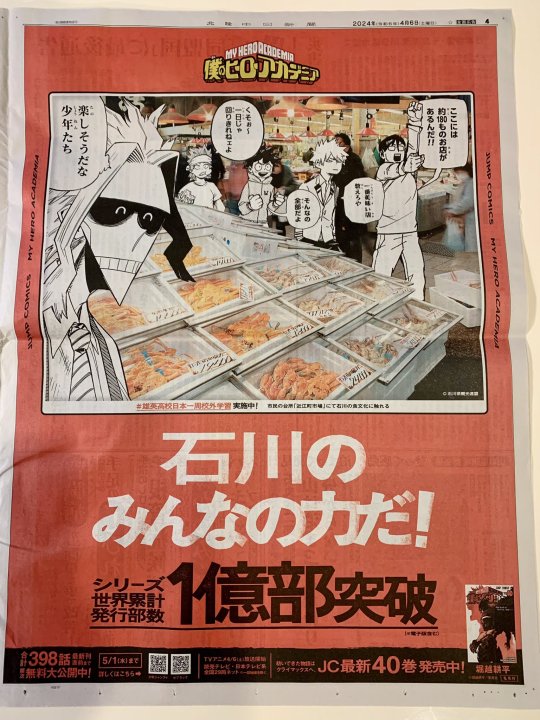
Photo credit: twitter user ESORA_artwork_
Iida: "There are approximately 180 shops in here!!"
Kacchan: "Tell me which one's got the tastiest stuff."
Izuku: "That's gotta be all of them!"
Kirishima: "Daaamn, there's no way you can go to all of them in one day."
All Might: "Looks like those boys are having fun, doesn't it?"
This is Omicho Market in Kanazawa, the capital of Ishikawa, a very busy market with fresh seafood, vegetables, fruit, and local specialties!
Fukui

Photo credit: twitter user mlluv1
Izuku: "Sauce katsudon originates in Fukui prefecture! ︎ The deep flavor comes from the sour sauce seeping into the cutlet! You could say the sauce is saving the cutlet, and the cutlet is saving the sauce. It's a food that embodies the concept of being able to save to win and win to save. I don't think it's an exaggeration to call it the soul food of heroes. Ahhh! I can't stop thinking that I want everyone in Japan to know more about this..."
Uraraka: "He's saying it's tasty."
One of Fukui's specialties is "sauce katsudon" wherein the pork cutlet is battered, coated in crumbs, deep fried, and then coated in a thick, sweet, tangy, savory sauce. "Katsu" means cutlet but it is phonetically identical to the word for win--the same one that's in Katsuki's name. Izuku is such a nerd, dear god. Special thanks to @pikahlua for saving my skin with Izuku's dreaded mumble-speech!
Yamanashi
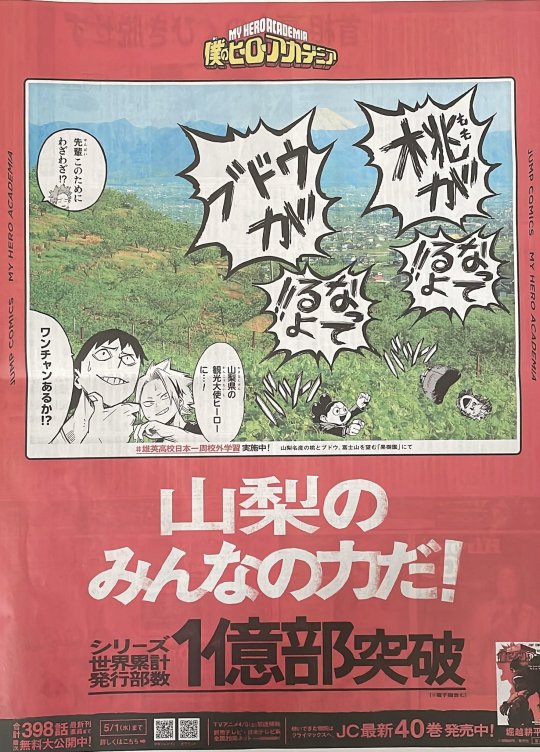
Photo credit: twitter user MARINJIJI
Mirio: "There's... A RIPE PEACH! There's... RIPE GRAPES!"
Kaminari: "The Yamanashi Prefecture Tourism Ambassador Hero...!"
Sero: "Have we got a chance!?"
Kirishima: "Sempai, you went out of your way just for this!?"
Yamanashi is one of Japan's big fruit providers with many orchards and vineyards, specializing in grapes, plums, and peaches. Mount Fuji is visible in the background! But Mirio... what were the ripe grapes!?
Nagano

Photo credit: twitter user hirom_1107
Hagakure: "Ojiro-kun! You really can't see it!?"
Jirou: "I can see it!"
Ojiro: "It's 'cause I've got a tail, isn't it. I wonder if they're feeling territorial..."
They are at Jigokudani Monkey Park with Japanese macaque (snow monkeys), who love to hang out in hot springs in the winter.
Gifu
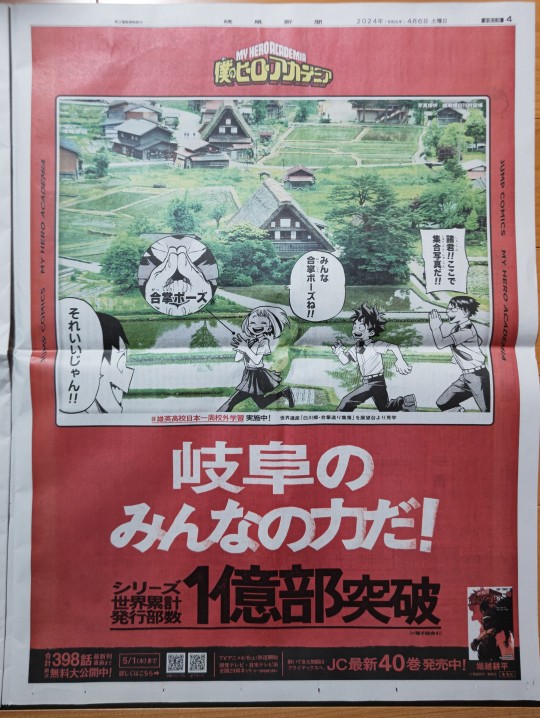
Photo credit: twitter user some_mitsu
Iida: "Everyone!! Assemble here for a group photo!!"
Uraraka: "Let's all do the gasshō pose, okay!!"
Sero: "That's great!!"
The Historic Villages of Shirakawa-gō and Gokayama are part of a World Heritage Site protecting the traditional gasshō-zukuri houses unique to the area. The style is named for the arch of the roof looking like hands in prayer; the area gets substantial snowfall every year, and the shape of the roof and structure of the walls are optimal for protecting the integrity of the house. I got to see and step inside this style of home at the Japan Open-Air Folk Museum, and they are absolutely incredible. The informational placards said that in years when the snow piles high enough, the second story windows are used as entrances!
Shizuoka
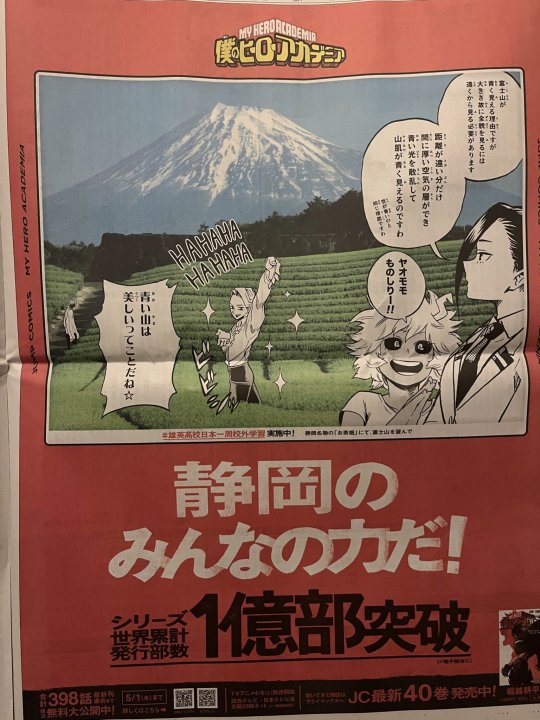
Photo credit: twitter user sugar_eraser
Yaoyorozu: "The reason Mount Fuji looks blue is because its size is so great that one must view it at a distance. This distance puts a thick layer of air in-between, scattering the light and causing the mountain's surface to appear blue. The sky is blue for the same reason."
Ashido: "Yaomomo's like a walking encyclopedia!"
Aoyama: "A beautiful blue mountain, you say? Why, there's one right here~!"
Viewing Mount Fuji from Shizuoka's famous tea fields. Shizuoka provides 40% of Japan's green tea! I've had a few varieties unique to their area, they were very flavorful and soothing. Aoyama is bein' vain because his surname means "blue mountain."
Aichi
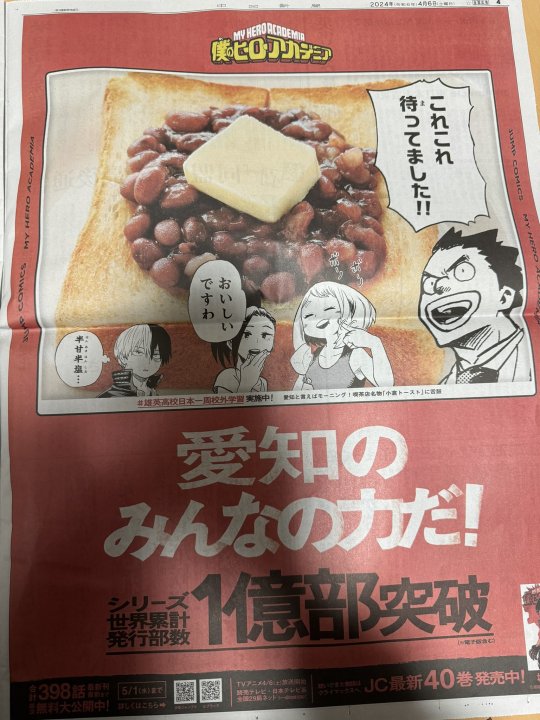
Photo credit: twitter user Hrkn1500
Satou: "All right, all right, now this is what I've been waiting for!"
Yaoyorozu: "It's delicious!"
Todoroki (thinking): "Half-Sweet Half-Salt..."
They are eating Ogura toast, a dish originating in a Nagoya cafe in 1921. Ogura jam is a sweet spread made out of adzuki beans, and it is often served with butter -- the butter being salted is the source of Todoroki's stroke of genius. I've had it several times, it's tasty!!
That's all for Day 3! See you soon for Day 4.
49 notes
·
View notes
Text
U.A. High School Field Trip Around Japan: Day 2 Translations
This is Day 2 of Shonen Jump's special commemoration of My Hero Academia reaching one hundred million copies worldwide, which is being rolled out daily across one-week in each prefecture's newspaper.
The schedule:
April 4th, Day 1: Hokkaidō & Tōhōku regions
April 5th, Day 2: Kantō region
April 6th, Day 3: Chūbu region
April 7th, Day 4: Kansai region
April 8th, Day 5: Chūgoku & Shikoku regions
April 9th, Day 6: Kyūshū & Okinawa regions
April 10th, Day 7: Nationwide release
You can see the illustrations on their website here, where they are released digitally the day after the newspaper release. Day 1, 2, and 3 are available right now.
I forgot to mention this in the first post, but every illustration features the celebratory text "It's the power of everyone in [prefecture name]! One hundred million copies of the series published in total worldwide." Very sweet.
Here we go!
Note: As I mentioned, the illustrations are available on the official site, but they are all rather small, which makes them hard to read, so in this post I have included photographs from fans which I used for my translations. Every photo was available publicly on twitter and I have credited the posters, but please be respectful and don’t draw undue attention to these fans. If anyone contacts me wishing for their photo to be removed, I will do so.
Kantō Region
Ibaraki

Photo credit: twitter user Bombe_Mina
Yaoyorozu: "The world's largest bronze Buddha statue, at 120 meters! The base alone is as tall as 1 Mount Lady. To the top of the head, the size is equivalent to approximately 6 Mount Ladies!"
Ashido: "1 Mount Lady?"
Tokoyami: "A unit of measurement...?"
Label on Mount Lady: "1 Mount Lady (approximately 20 meters)"
Ibaraki's city Ushiku boasts the Ushiku Daibutsu, a massive Buddha with an elevator and observation deck. At the time of its construction in 1993, it was the world's tallest statue, but now stands as the fifth tallest. 120 meters is ~390 feet, with 1 Mount Lady equaling a little over 65 feet.
Tochigi

Photo credit: twitter user gekka6066
Bakugou: "I ain't doing it again, you hear!! Dammit!!"
Kaminari: "I wanted to try it at least once!"
Tochigi's Mount Iwafune is famous for being a filming location in a number of Tokusatsu (stylistic, special effects-heavy) series and movies, in particular Super Sentai. There are hilarious tourist experiences you can book, like Willer Express's "Bakuha Tour" where they shuttle you to the location in a limousine and stage a professional photo shoot with big explosions to make you "look like a superhero."
Gunma
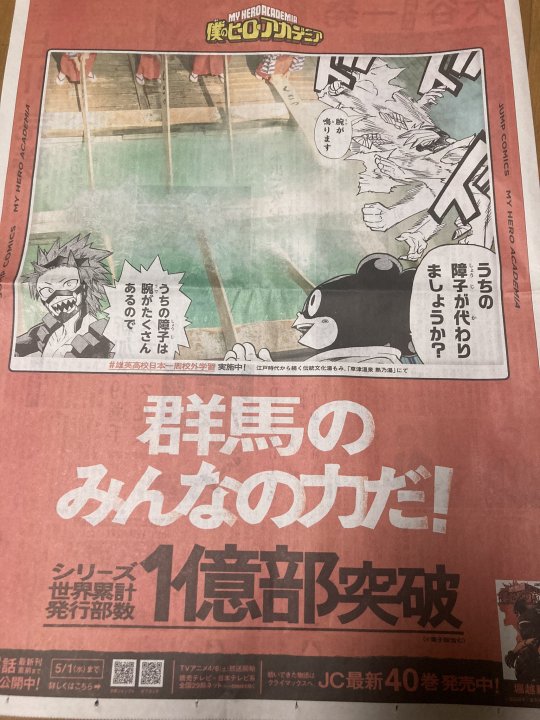
Photo credit: twitter user X_kt8610
Shouji: "Hear my arms roar."
Mineta: "Shall our Shouji take your place?"
Kirishima: "He's got lots of arms, after all!"
Gunma's Kusatsu town is famous for its hot springs, numbering about one hundred. The local water can be a ferocious ~54 degrees Celsius or higher (~130 degrees Fahrenheit) making it too hot to bathe in normally. Class 1-A is visiting the hot spring Netsu no Yu which hosts a yumomi ceremony, dating back to the Edo era, wherein women jostle the water back and forth with long wooden paddles to release the heat and cool it down enough for people to bathe, without diluting the water's unique mineral properties. They sing a folk song to keep a steady rhythm, perform a dance, and at the end, those who come to watch are allowed to try it out!
Saitama

Photo credit: twitter user hq_jojo
Hagakure: "I was real anxious holding our place by myself."
Uraraka: "Eh!? Hagakure-chan, who asked you to reserve us a spot when you're see-through!?"
Kaminari: "Heeey! Sorry to keep you waiting!"
They are attending Saitama's Satte Cherry Blossom Festival, which the little informational tagline says features about 1,000 blossoms along a single kilometer. I guess Ochako doesn't think anybody will respect the dibs claimed by a set of shoes and floating gloves.
Chiba
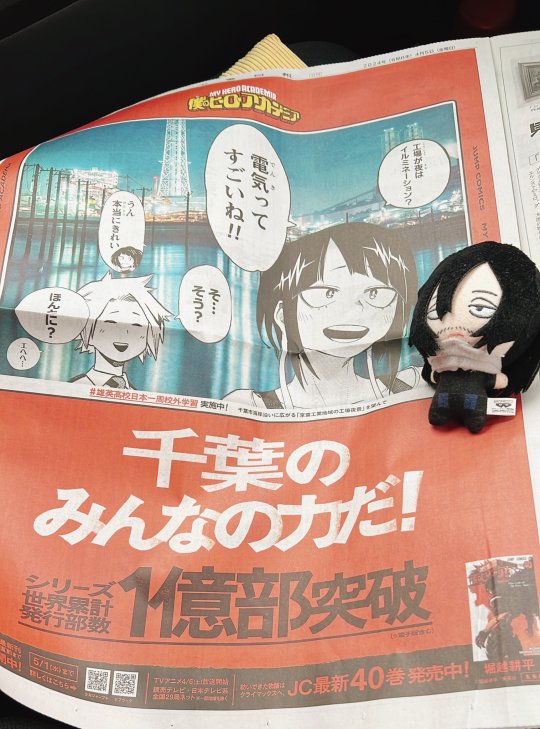
Photo credit: twitter user unon330
Jirou: "The factories get lit up at night? 'Electricity' is amazing, huh!"
Kaminari: "Y...you think?"
Jirou: "Yeah, it's really pretty."
Kaminari: "Really?"
Jirou: "Ehehe..."
Jirou and Kaminari are looking out at the Keiyō Industrial Zone, reclaimed land off the port of Chiba which spans across eight of its cities and produces electricity, petroleum, steel, and a number of other things. The joke here is that Kaminari's given name is Denki, phonetically identical to the word for "electricity," so it sounds like Jirou is gushing about how cool and good-looking he is!
Tōkyō
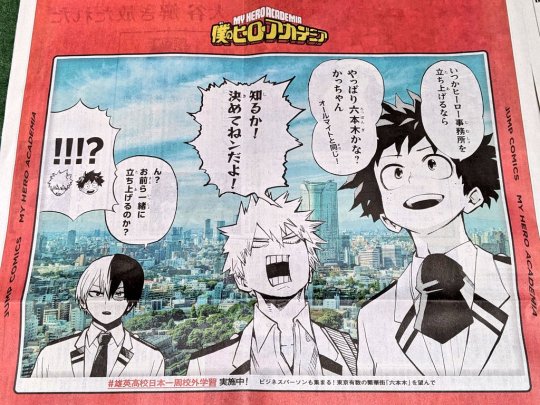
Photo credit: twitter user jasum1nsan
Izuku: "If you were gonna open a hero agency someday, you'd definitely go for Roppongi, right, Kacchan? Just like All Might!"
Kacchan: "LIKE I'D KNOW!! I haven't decided yet!"
Todoroki: "Huh? Are you two opening an agency together?"
bkdk: "!!?"
The two words that best describe Roppongi are "affluent" and "international." From the 1960s on, it has been developed into an upscale business sector with foreign embassies, and it is hugely famous for its nightlife. Historically, the district's reputation was tied to organized crime (yakuza), though that has lessened in recent years. All Might opening an agency in Roppongi encapsulates all these things: 1. he's the number one hero, so he can afford the very best office space, 2. his character has both a symbolic and literal relationship with America, and 3. he ambitiously and strategically placed himself at the very "heart of crime."
The way Izuku asks Kacchan's opinion doesn't explicitly clarify who is opening the agency--you could translate it more open-ended, and even Kacchan's response could be interpreted as "Who knows! We haven't agreed on it yet." Todoroki's assumption that they are negotiating amongst themselves is actually pretty reasonable. What nerds!!
Kanagawa

Photo credit: twitter user ___m1O16
Uraraka: "You can even enjoy yourself free of charge! The ocean's so great."
Kirishima: "IT'S PRICELESS!!"
Izuku: "I want heroes to protect this kind of carefree happiness for everyone."
Asui: "This is the best kind of memory to make."
The gang are watching the sunrise over the sea looking out at Enoshima, a very small island off the southern coast in Sagami Bay. Izuku is such a sweetie, hang on, I'm clutching my chest a little here.
And that's all for Day 2! Day 3 translations are coming soon and I'm collecting Day 4 right now.
75 notes
·
View notes
Text
U.A. High School Field Trip Around Japan: Day 1 Translations
To celebrate My Hero Academia reaching one hundred million copies worldwide, Shonen Jump is releasing special illustrations in the newspapers of Japan's 47 prefectures, calling it "U.A. High School Field Trip Around Japan." It's being rolled out daily across one-week.
The schedule is:
April 4th, Day 1: Hokkaidō & Tōhōku regions
April 5th, Day 2: Kantō region
April 6th, Day 3: Chūbu region
April 7th, Day 4: Kansai region
April 8th, Day 5: Chūgoku & Shikoku regions
April 9th, Day 6: Kyūshū & Okinawa regions
April 10th, Day 7: Nationwide release
You can see the illustrations on their website here, where they are released digitally the day after their newspaper release, so Day 1 and Day 2 are available right now.
The illustrations depict charming scenes between Class 1-A about something related to each prefecture's culture or history, so I thought it would be really fun to translate them and share a little bit about Japan.
Here we go!
Note: As I mentioned, the illustrations are available on the official site, but they are all rather small, which makes them hard to read, so in this post I have included photographs from fans which I used for my translations. Every photo was available publicly on twitter and I have credited the posters, but please be respectful and don't draw undue attention to these fans. If anyone contacts me wishing for their photo to be removed, I will do so.
Hokkaidō Region
Hokkaidō

Photo credit: twitter user URix0307
Iida: "Heroes! Be ambitious!!'
Aizawa: "I'm leaving you behind."
Iida is standing in front of the statue of William S. Clark at Hitsujigaoka Observation Hill, a scenic spot in Sapporo. Clark worked with the Japanese government to found Sapporo Agricultural College (now Hokkaidō University) in 1876; he is a very famous figure in the history of the region. The statue is inscribed with a quote attributed to him as he left Japan: "Boys, be ambitious!"
Tōhōku Region
Aomori
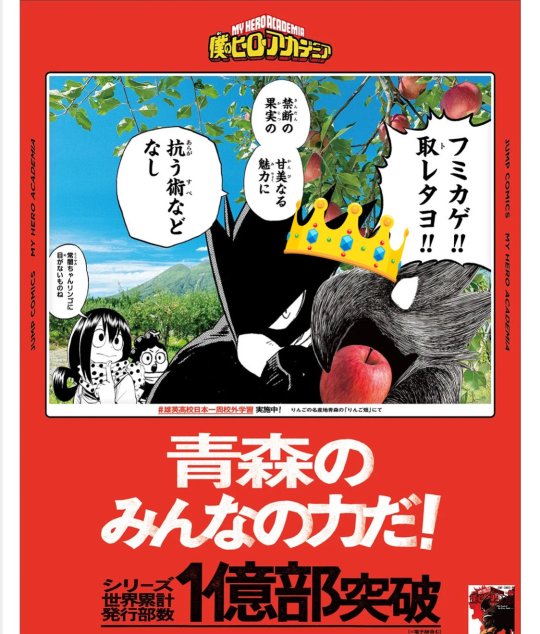
Photo credit: twitter user redaotkrsn
Dark Shadow: "Fumikage!! I GOT ONE!!"
Tokoyami: "The allure of forbidden fruit which tastes so sweet..."
Dark Shadow: "One simply cannot resist!"
Asui: "Tokoyami-chan sure likes apples, huh?"
Agriculture is huge in Aomori, and specifically they are famous for their apples, contributing about 60% of Japan's entire apple production. Raw apples, jams, juices, desserts, etc., they are everywhere in Aomori, and fyi, they are all absolutely delicious. The sweetest, richest, freshest apples I've ever had in my life were the ones I had here! Dark Shadow is right, one simply cannot resist!!!
Iwate

Photo credit: twitter user bakkk_17
Todoroki: "I can have as many bowls as I want, right?"
Endeavor: "SHOUTOOOOO!!!"
Kouda: "Todoroki-kun!! Your dad said he wants to eat with you, too!!"
Todoroki: "Check, please."
Todoroki is eating wanko soba, a specialty from Iwate where it's basically an all-you-can-eat. The soba is served in many small bowls, and you slurp them up and immediately get served more. The verb he uses, ikeru, is one people also use for "holding your liquor well," which I personally found hilarious. "Oh yeah, I can hold my noodles."
Miyagi
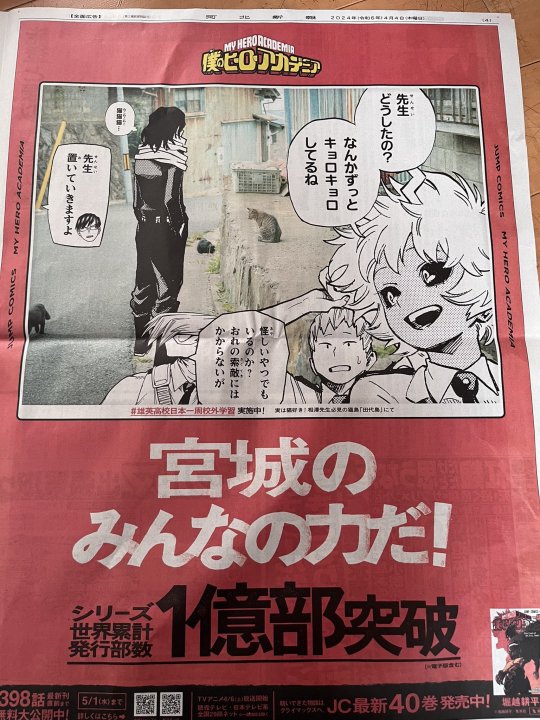
Photo credit: twitter user Abino_Haru_Maki
Ashido: "Teacher, what's wrong? You keep lollygagging about!"
Aizawa: "Kittykittykitty..."
Shouji: "Anybody suspicious around? Nothing has come up in my search for enemies."
Iida: "We're leaving you behind, teacher."
Miyagi is famous for being home to Tashirojima, the so-called "Cat Island" where cats outnumber people. Iida gets revenge!!
Akita

Photo credit: twitter user kado0730
Hagakure: "Namahage faces are so scary!!"
Kaminari: "Looks just like Bakugou, don't it."
Bakugou: "THERE'S NO RESEMBLANCE AT ALL, I'LL SEND YOU FLYING!!"
Sero: "He's a rotten kid who looks just like a Namahage!"
Namahage are frightening folkloric figures from Akita's New Year's festival. Men wear big demon masks and straw coats and wield a (fake) weapon; they march through the streets or knock on doors to scold misbehaving children, asking if there are any "warui ko," (naughty/rotten/bad kids), which is what Sero calls Bakugou.
Yamagata
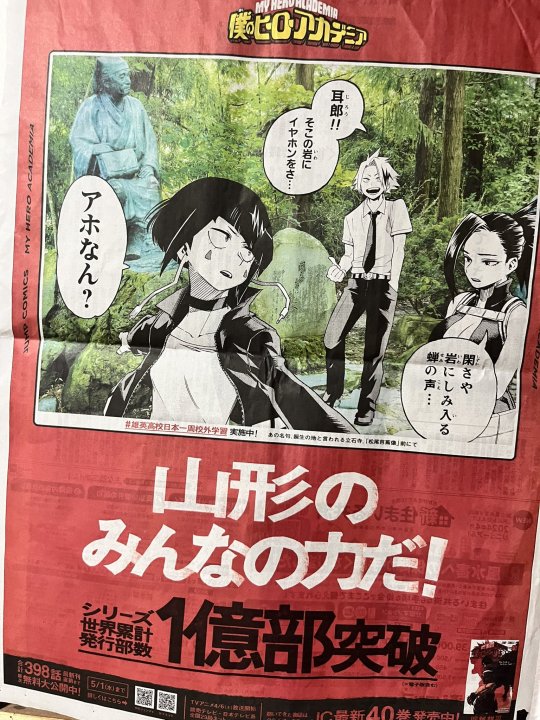
Photo credit: twitter user ha_n_a_0
Yaoyorozu: "Oh, tranquility! Penetrating the very rock, a cicada’s voice."
Kaminari: "Jirou! How about you put your earphones on that rock?"
Jirou: "Are you stupid?"
Yaoyorozu is reciting a famous poem by Basho Matsuo written when he visited the Buddhist temple, Risshaku-ji (also called Yamadera, meaning "mountain temple"). This translation is by Helen Craig McCullough. Risshaku-ji, a National Historic site, is home to a number of beautiful buildings and statues built into the mountainside; temple history claims a lineage back to the 9th century. The trail up to the temple consists of 1,015 steps; I visited in winter, which made it quite the precarious climb!
Fukushima

Photo credit: twitter user kingyo0927
Kirishima: "This right here is what I should be aiming for!!"
Aoyama: "A fateful encounter~!"
Bakugou: "When I said 'just being able to keep standing through anything makes you crazy strong,' this ain't what I meant!!"
Kirishima is looking at rows of okiagari koboshi, which are traditional papier-mâché dolls popular in Fukushima's western Aizu region. They are weighted so that no matter what you do to them, they pop right back up to standing!
That's all for Day 1! I'm still translating Day 2 and collecting Day 3's as they roll in, so please look forward to those. :D
123 notes
·
View notes
Note
So it’s true what they say about you...
Yes, unfortunately it's true...
16 notes
·
View notes
Text
Let's entertain a scenario real quick.
Person A wants to enter Person B's home. Person B blocks the door physically, making it clear that Person A is not welcome.
Person A looks right at Person B and says, "Excuse me."
We can all agree that Person A is absolutely not being polite, right?
In fact, they are using politeness as a tool of aggression in a sense. Their words are only superficially polite; their actions completely disregard the wishes of the other person as they impose their own will on the situation. Person A is saying "Excuse me," but they mean, "Get the hell out of my way."
People can use politeness to be defiant, to buck authority, to be passive aggressive, back-handed, or even sarcastic. Interpreting their words at face-value ignores the many intentions that exist behind niceties.
Izuku responding to "Die" with "Pardon the intrusion" is incredibly funny. It is so sassy, so contrarian. In my experience, you usually say "ojama shimasu" as you are doing the physical act of entering a space. He is denied entry, yet he responds as though he is already entering, because he cannot be deterred from it.
Sure, Izuku is a nice, polite, well-behaved boy on the surface. But when push comes to shove, he shows himself to be a stubborn little busybody with deep, unshakeable convictions, who will absolutely ignore, resist, and argue with anyone who gets in his way when he is trying to do what he believes is right to help people.
When Izuku told Tomura, "You're human," it was a threat. It was both compassionate and terrifying, because Tomura keeps rejecting his help and insisting not only that he can't be saved, but that he doesn't want to be. And Izuku doesn't care. He wants to save that little boy, and by god he is going to do it, whether Tomura likes it or not.
I hope this will be short.
I guess this line is the fandom drama of the chapter?

I understand a lot of you are really passionate about the accuracy of the English translation. I just want to encourage you to try to engage with the official translation in good faith.


Ojama shimasu literally means "I am disturbing you/I will get in your way." It's often spoken as a greeting where the "apology" is implied (hence the brackets in my translation), but as usual context is everything in Japanese. Izuku is saying this line in defiance of Tomura's wishes. It basically comes across as Izuku plugging his fingers in his ears.
Me personally? If I were the official translator, I'd have strongly considered translating the line as "I'm coming in whether you like it or not."
The purpose in my pointing out the "common greeting" nature of this line was to demonstrate Izuku's sassiness. This is Izuku doing his "meddling where you don't technically have to" thing. The level of formality in Izuku's speech doesn't necessarily translate to actual politeness (check out @bakuhatsufallinlove's excellent post on that here).
Does "You will let me in," mean the exact same thing? Technically no, but it's the sentiment that counts. From an official translator's point of view, "You will let me in," is shorter, punchier, fits in the speech bubble a lot easier, and still conveys the general idea of what's happening in the scene.
I don't know. I wanted to talk about this because I guess a lot of people are concerned about Izuku's characterization and how it reflects on Japanese culture and how the official translation may be misrepresenting Japanese culture to the English-reading audience, and I just...can I ask that everyone take a step back a minute? Horikoshi isn't writing his story for an English-reading audience. He's not considering at all how any of this sounds to English speakers. That's the translator's job, not just to translate what is said but to translate that into the context of who is reading it. Localization is not a dirty word--it's an important aspect of translation. And the notion that Izuku is being polite and respectful here as a Japanese person is just such a...take. Izuku is being hella rude here lol. Japan itself, not just the MHA Japan but REAL WORLD Japan, notoriously has a bystander problem where people will ignore others who are being harassed because they don't wanna get involved. They won't step in to help nor will they even testify as a witness against others for fear of what it means to speak out and break from the pack. Izuku is quite obviously Horikoshi's direct answer to that phenomenon. He's meant to be an example of the morally correct thing to do, which is to be "rude" in these cases.
So I mean, sure, we can talk about what is lost in translation by the line, "You will let me in." But to me what's lost may just be grammatical and pedantic (like the passive voice that switches the onus of action onto Tomura instead of Izuku and what that may do to the focus on Izuku's rise to action here). In any case, it's not a BAD translation that changes Izuku's perceived politeness, just one that may prompt new discussion--and I don't think that's a bad thing.
#there are a number of times Viz implements its In-House Aesthetic on Izuku's dialogue#to make it sound edgy or tough or cool to English speakers#when the Japanese doesn't read particularly strong in that regard#I'm not a fan of most of those instances#they feel like very weird interpretations of his general demeanor and way of expressing himself#but this is an interesting choice#that at least to me indicates an effort to highlight an important part of his character#incorrigible defiant hero deku#who does the right thing even when all of society tells him not to#mha manga spoilers#translations#meta#mha 417#the pika special
162 notes
·
View notes
Text
apparently I cursed tumblr or something, my epic, image-heavy long post is somewhere in between planes of existence
5 notes
·
View notes
Text
Omae Part 2 Electric Boogaloo
Tomorrow is the one-year anniversary of my post Omae: Complexity of Self-Expression and Intimacy in the Japanese “You.” In honor of it, I’m doing a follow-up post.
Why? Because I made two claims in that post:
“as far as I can tell, Izuku is the only person Katsuki has ever used the pronoun omae (おまえ) towards in-canon”
“Furthermore, he has only used omae towards Izuku on three occasions.”
I prefaced both with “as far as I can tell” because I had some doubts that Katsuki’s use of omae was exactly that exclusive, but I knew it was pretty damn exclusive, so I went ahead and wrote the meta anyway. And I still stand by my assessments of how he uses it and what those moments mean.
But I was wrong on both counts.
Katsuki has used omae towards people other than Izuku.
He has used omae towards Izuku on five occassions, as of chapter 409.
Of course, chapter 409 wasn’t released until months after I wrote my pronoun meta, but at the time of my post, I had in fact missed one pivotal omae directed at Izuku that occurs much earlier in the series.
I wanna talk about those two extra omae towards Izuku and who else he has used omae towards. Much like Katsuki, I am a perfectionist, so if I'm gonna revisit this topic, I'm gonna go all the way.
So, I went through 409 chapters and catalogued every single time Katsuki uses a second-person pronoun.
STRAP IN, BUCKOS.
An Exhaustive Analysis of Bakugou Katsuki’s Second-Person Pronoun Usage
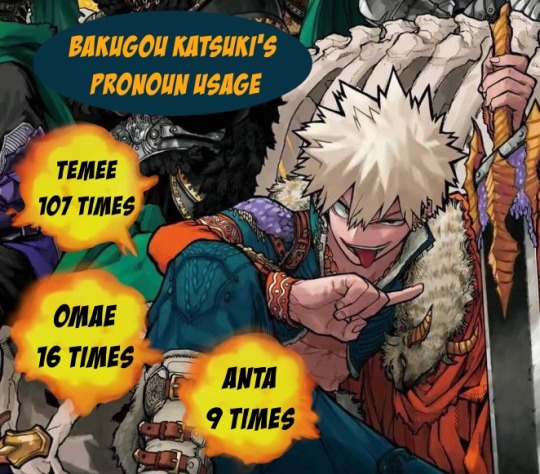
These are all the “you” pronouns Katsuki has used in the manga. We’ll go over them one-by-one and talk about who he uses them for, when, and my thoughts on why.
First, a note about rudeness: In many languages, and certainly in Japanese, familiarity and rudeness go hand-in-hand. In dictionaries and on grammar websites, you’ll see advice about using a term only with “people above you” or “people equal to or below you.” In general, you are either talking up to someone (polite speech) or you are talking down to them (casual speech). Excluding outright derogatory language, talking down to someone is the same as treating them as your equal.
Talking up creates or maintains distance between parties. Casual speech, familiar terms, and directness are nuances that generally get introduced into relationships as they deepen. Basically, being close to someone gives you the “right to be rude” to them. To speak this way with a stranger or people who are your hierarchical “social superiors” is considered rude in part because you lack an established (or equal) relationship with them.
I mention this because I think some people are under the misapprehension that for Katsuki to show someone he cares, he would have to speak respectfully towards them—that is, talk up to them. That simply isn’t the case, and in fact such behavior might convey callous indifference instead, because switching from casual speech to formal speech with someone you have history with puts distance between you, pushing them away.
Instead, there are more nuanced ways to connect and affirm bonds. Katsuki using omae rather than temee, for example, is not him being more polite, he's just being less insulting. He is still talking down, and one could argue that by refusing to talk up to anyone, Katsuki treats everyone equally. I mean he is still a foul-mouthed little monster, but you know, at least he’s consistent about it.
Anyway, keep this “right to be rude” in mind.
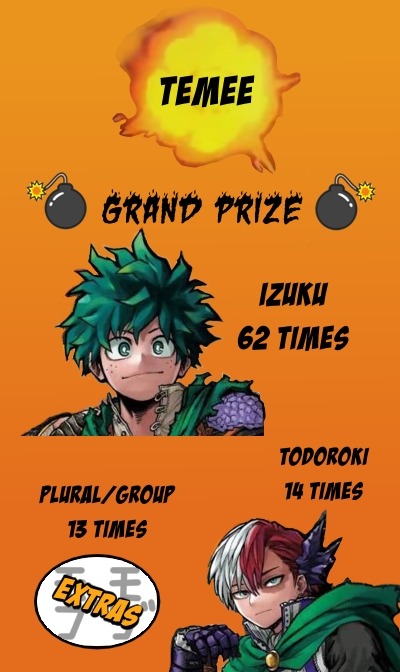
As mentioned in my first post, temee is basically Katsuki’s default second-person pronoun. If he’s addressing someone directly and he isn’t using one of his mean nicknames, it is almost guaranteed to be this word. This graphic is the only one that is not exhaustive, featuring just the top three.
Temee is derogatory; it is often translated as “you bastard,” and even when it’s not, its presence encourages translators to slather a veneer of rudeness across the sentence as a whole. Unlike the other pronouns we’re going to talk about, there is basically no scenario where you could use temee and not come across like an asshole. You could use it with friends or family to joke around, but you’re still being an asshole, just a funny one.
And... can we just acknowledge the vast gulf between Izuku’s 62 and runner-up Todoroki’s 14? Obviously Izuku is the protagonist, so it makes sense that much of the dialogue we are shown from any character is about him or directed at him. But it’s also just really funny.
No single use of temee is particularly notable since it's so common, but it is obvious why these two are at the top of the list: Katsuki has a lot of scenes with them, and he considers them his rivals. As a result, they tend to throw him into a tizzy often.

Anta is a contraction of anata. If avoiding a “you” pronoun entirely is the most polite way to refer to someone, anata is arguably the next most polite way. It is considered polite towards someone of “equal or lower status,” but can seem distant—you hear it in commercials when the narrator has to address the audience, “you, the customer.”
Anta strips away that distance and expresses either familiarity or contempt, depending on how you want to read it, which makes it pretty fucking funny that Katsuki uses it for his mentor figures. It is worth noting that anta is significantly less offensive than his typical temee and arguably even omae. A normal person would never use anta towards their boss or teacher—or their lifelong idol, for that matter—because it is talking down, which puts them on your level. But Katsuki’s whole persona is built around rebellious superiority, so out of all the options, he affords All Might and Best Jeanist the least offensive pronoun he can stomach using. Essentially, “I’m not gonna be fuckin’ polite but god, fine, I’ll be LESS rude, I guess” while still maintaining plausible deniability.
I also wanna note that there are instances where Katsuki technically uses temee towards All Might and anta towards Izuku, because he uses them in the plural form to refer to both of them at once. It’s actually pretty interesting to see who is framed as the “primary subject” of his scolding based on which pronoun he uses.
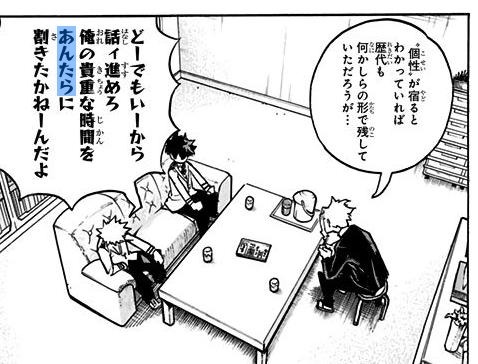
Chapter 257
All Might is the one droning on and on, so Katsuki’s response pluralizes his All Might pronoun anta into antara, lumping Izuku in with him. Basically: “stop wasting my time and get to the point (and that goes for you, too, Deku).”

Here we’ve got him pluralizing temee and, between All Might and Izuku, it’s definitely more the Izuku pronoun. So this reads a little like “dammit Deku you kept this secret so badly I found out and then you swore me to secrecy but you’re STILL UTTER SHIT AT HIDING IT so you are MAKING MY LIFE EVEN HARDER (and you, All Might, don’t you fucking know better??)”
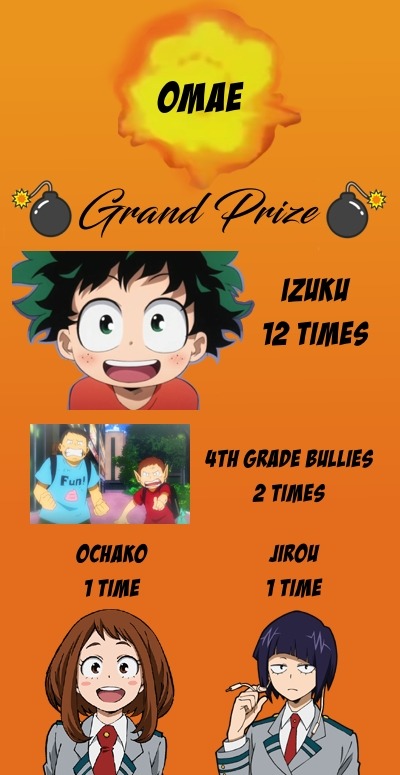
Aaaand now we’re at the good shit. Okay, let’s break it down.
Ochako

Chapter 36
Katsuki addresses Ochako with omae at the very start of their Sports Festival battle, and this is in fact the first time he addresses her personally with a second-person pronoun. It’s a great writing choice: unlike every other fight we’ve seen Katsuki in so far, he isn’t busting out his typical boisterous insults. Rather, what he says reads as a measured assessment of her as a threat, and omae contributes to this. Had he used temee, he might still have come across this way on the whole, but the use of omae as the first word out of his mouth—when the audience knows he uses temee—sets this moment apart even more.
The text of Uraraka vs. Bakugou isn't ambiguous: Katsuki takes Ochako seriously, immediately, when no one else does. This is of course a rejection of sexist assumptions about girls, but it is also because Katsuki is smart. Kaminari’s battle is the foil to this fight. Where Bakugou succeeds, Kaminari failed, having been too sexist, cocky, and just plain dumb to properly assess his opponent and the danger they pose to him.
I said in my first post that Katsuki’s omae towards Izuku immediately after Deku vs. Kacchan 2 reads as him addressing Izuku as an equal, and I would say the same is true here.
After Ochako tries to execute her plan and Katsuki accuses her of colluding with Izuku, he uses temee towards her. It’s his standard choice, of course, but the change feels a little loaded in hindsight. She might have been afforded a different pronoun once, but she quickly gets lumped into the temee pile at least partly due to Proximity To Deku.
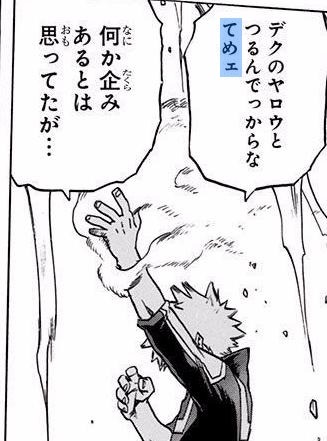
Katsuki talks the most shit when he’s on the ropes—a strategic, cocky camouflage for his vulnerability. We know from his thoughts watching Todoroki vs. Midoriya that at this moment, he was pretty worried he was at his limit. But Katsuki also likes a good challenge, and he respects people who can give it to him, so in gearing up for the climax of this fight, he calls her by her surname.
The progression: omae + mean nickname → temee → surname.
In later scenes, he addresses her with his typical temee, which just goes to show you that Katsuki really picks and chooses his moments.
Or, as All Might put it:
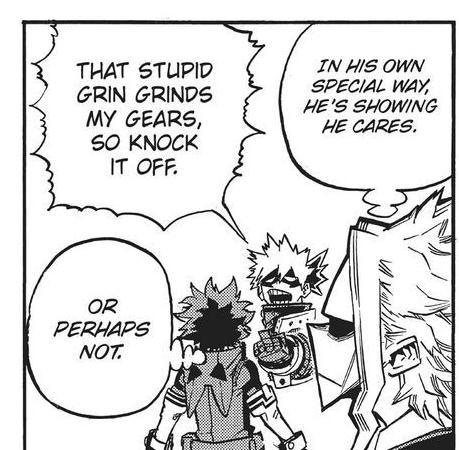
Speaking of picking and choosing his moments, this next one was a delight to discover.
Jirou

Chapter 182
As with Ochako, this is the first time Katsuki uses a "you" towards Jirou personally. To be precise, what he uses is a sound-shifted variant of omae pronounced omee (written variously as おめえ, おめー, and おめぇ). We’ll talk about whether that means anything later.
This occurs during the school festival when Jirou belts her heart out suddenly. Katsuki thinks back to how the band had criticized his improvisation and her specifically telling him not to do it during the show. So he says out loud, to himself, “omee ga surun kai,” for which I think the funniest translation would be, “OH BUT YOU CAN DO IT, HUH??”
The official English translation is “hypocrite!” which isn’t bad, but yeah, he is being such a grumpy little sarcastic baby about it, it’s very funny. Just muttering complaints under his breath, with no actual ill-will attached. The fact that he uses omee reinforces the sense that this is not a serious complaint; it’s good-natured ribbing and contributes to the reader’s awareness that Katsuki likes and respects Jirou.
While Kaminari and Sero mischievously try to trick him into participating in the festival, Jirou earnestly asks for his help while acknowledging his skill.

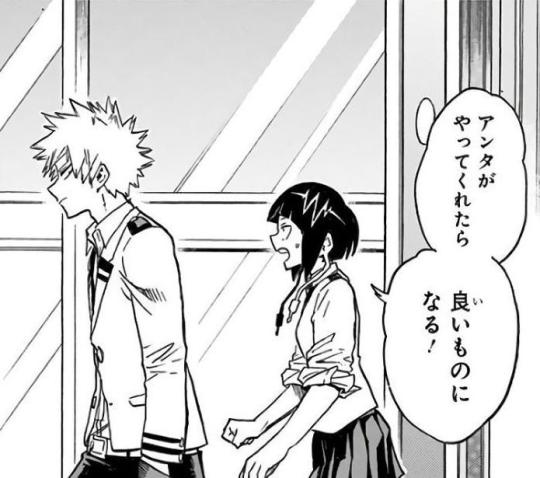
Chapter 171
On top of outright asking "onegai" (please, but literally: "a request"), the verb construction she uses (やってくれたら, yatte kuretara) frames his participation as a favor; kureru is basically “to do for the benefit of someone else [often to your disadvantage or inconvenience].” And then she personally works her ass off to make their performance the very best it can be.
Later during the Joint Training Battle, Katsuki relies on her, uses a nickname for her (to her annoyance), and saves her. Kirishima and Kaminari both astutely comment that the festival band reinforced Katsuki’s trust in his classmates and his willingness to work with them towards success.
In this moment during the festival, Katsuki is letting Jirou shine, because each of them doing what they do best is what makes the performance a triumph in the first place.
But the boy’s still gonna be a bossy little tsundere about it.
4th Grade Bullies

Chapter 62
In Izuku’s flashback, little Katsuki uses omaera (plural form) towards the 4th graders who pick a fight with him.
You might be thinking, “Hang on, haven’t all the omae uses so far been for people Katsuki likes or at least respects? So why is he using it for these two?” And you’d be right, at least when it comes to present-day, teenage Katsuki using omae, because it’s no longer his default.
Flashbacks to Katsuki and Izuku’s childhood tell us that Katsuki’s default peer address as a kid was most likely omae, and that he switched to temee as he got older and became more of an obnoxious little shit. I emphasized in my first post that omae seems softer coming from Katsuki because it’s a departure from his normal way of speaking. The flashbacks show us a time when he was... kinda just a regular kid using language common among boys his age.
Still, there is a “cool tough guy” air to this moment, because omae can also come across as contemptuous—which is how Izuku uses it towards villains in present-day. Izuku uses boku for himself and kimi for peers, the combination of which tend to be seen as kind of soft and boyish, rather than macho and cool. Little Katsuki uses the boastful pronoun ore for himself and omae towards the bullies, who are both older and therefore technically "above" him.
So Izuku marvels at Kacchan, who talks big and tough like a grownup. Kacchan who can do anything, who stands his ground, fights to win, and invokes the heroic ideals of All Might.
Izuku
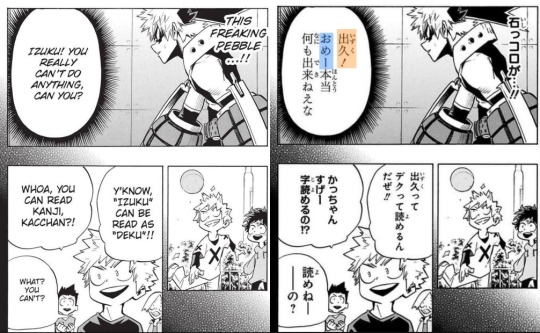
Chapter 9
The first time we see Katsuki call Izuku by his name is when we learn the origins of the nickname Deku. It also happens to be the first time we see Katsuki address someone with something other than temee. This scene shows us a glimpse of what their relationship looked like before it totally fell apart: before Katsuki nicknamed him Deku, he called him Izuku. And before Katsuki started hurling insults and screaming “you bastard” (temee!) at Izuku all the time, he used a different “you” word for him, too. Little Katsuki addressed him as a little boy would address a peer or a friend.
It made me wonder… is the aftermath of Deku vs Kacchan 2 the first time Katsuki has addressed him as an equal since they were little kids?
And, furthermore, little Katsuki uses the sound shifted variant, omee.
You might be surprised to learn that temee itself is a sound shifted variant of temae (手前, てまえ). Temae literally means “before the hand” and historically, it was a humble first-person pronoun, meaning “me, who stands before you.” Omae (お前) literally means “the one before [me],” it was historically very polite and only used for extremely high-class people. Somewhere along the way, temae became a second-person pronoun like omae, and both started to be perceived as quite rude.
Tough guy Japanese speech patterns are epitomized by sound shifts and bitten off words. Supposedly, this dialect originates in Tokyo’s historic Shitamachi area, which is characterized as rough and working class in sharp contrast to the wealthy, high class Yamanote area.
So, does omee mean something different than omae? Maybe, but not always. Does it mean something different when someone says “Thank ya” rather than “Thank you”? Or when someone says “y’all” rather than “you all”? Not exactly, but… does it feel different? It can.
Little Katsuki’s sound shift links this moment to our last example:

Chapter 409
As you acquire language, you develop a personal relationship with it informed by your experiences. More than just dictionary definitions, you gain cultural and emotional associations, and that impacts how you interpret media and other people. I don’t think anyone can say that omee definitively conveys something different than omae, but I do know that when I personally read Katsuki use it in 409, the shift feels like casual fondness. Like letting down your guard. A reassurance spoken softly. It somehow feels just a bit softer than if he had enunciated omae.
Years ago, Katsuki used it to tease Izuku about how he can’t do anything. And four hundred chapters later, he uses it to say “I won’t get in your way anymore.”
You should read pikahlua's really, really good meta about what this line means.
Whether it was intentional on Horikoshi’s part or not, I think it is a meaningful callback. These are the only two times Katsuki has ever used omee towards Izuku. It emphasizes how he has changed, yes, but it also ties in the context of his own past "uselessness" and how he has surpassed it, that he won't ever again be "a weakness others can exploit" to get to Izuku. But also, as pika says:
(And I read that he’s ready to let Izuku be the main character.)
The only other time Katsuki has used omee is towards Jirou, when he affectionately teased her for being a hypocrite while also making sure she got her time in the limelight.
And what does Katsuki think in the next chapter?

“Izuku, do your best.”
Izuku gets his time in the limelight. They each brought their own strengths to this final battle, and Katsuki has held up his end. He wasn’t a burden, he didn’t hold Izuku back—he came back from the dead, saved their hero, and took out All For One. Now Izuku has to do what he does best.
A lot of the things I said in this post simply reiterate the meaning of the text itself, and that's because the nuances in Katsuki’s dialogue support the narrative. They reinforce what the story tells us about him and his relationships, and I think that's pretty amazing.
#bkdk#translations#meta#mha 9#mha 36#mha 62#mha 171#mha 182#mha 202#mha 257#mha 409#mha manga spoilers
274 notes
·
View notes
Note
In regards to your post on Izuku’s self sacrificial traits, how do you think the dark hero arc plays into this? I thought the point of it was to sort of pull his self sacrificial nature back a bit with the whole “you can’t do it on your own” and “don’t kill yourself for the cause” thing. They don’t have to be mutually exclusive, i get that “bakugou looks up to Deku’s self sacrificial nature as a positive trait he doesn’t have” and “Deku should rely on others and not hurt himself” can both coexist. But they also give mixed messages narratively. Is one not condemning it while the other puts it on a pedestal?
THANK YOU!!! For taking the bait.

I've been ranting about this theme a bit because, from what I can tell, it might be the biggest point MHA is trying to make to answer the question "What is a hero?" Because of MHA's length, the points of the argument have been rather spread out. I think people's understanding of the argument has been distorted by the length of time between the points. Overthinking is the enemy here.
But really, why are people coming away from MHA with the message "Heroes shouldn't sacrifice themselves"? The message is coming from somewhere. The problem is it's probably coming from a conflation of concepts. What is self-sacrifice? That's the question that gets at the root of the problem here.
In the west, "sacrifice" has negative connotations. "Something is lost." "Someone suffers for the sake of a goal." "Someone gives up something." The focus is entirely on the pain experienced by the one sacrificing.
But the point MHA is trying to make is that there's a difference between "suffering loss" and the sacrifices a true hero makes. Izuku isn't a remarkable hero because he's willing to destroy himself at the drop of a hat. The focus is not on his drastic behavior but on the recipients of his drastic behavior. The point is, sacrifice for the sake of sacrifice is meaningless, but sacrifice for the sake of others, well, now we're getting somewhere.
It's the "for the sake of others" part that matters here. Izuku is a hero because he cares for others, because he wants to save others, and what he's willing to sacrifice to accomplish that is merely the measure of his conviction, of his heart.
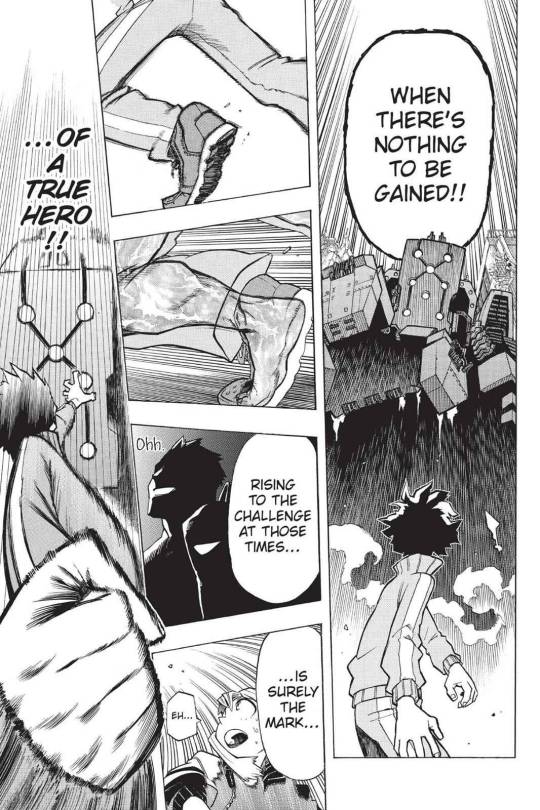
The quality of self-sacrifice is a core trait measured just to gain enrollment at UA, the most prestigious hero school in the country. Self-sacrifice is fundamental to being a hero. Do you really think the point of the MHA story is to demonstrate how self-sacrifice is a bad thing, that heroes shouldn't sacrifice themselves? Do you think the rest of Class 1-A wouldn't be willing to sacrifice themselves should the need arise so long as it's in order to save someone?

The difference between Izuku and the rest of the world, at least at the beginning, is that he is sensitive to calls for help. He is able to perceive those in trouble that others cannot perceive. Others get confused by the context or are not in a constant state of listening for cries for help. Others cannot always tell when is the right time to act or if acting is the correct choice. Izuku never wavers in the face of such questions. He always acts, because he cannot help but act. It is who he is. It's his nature to be this way. And this is the spirit that slowly influences his classmates and the rest of society, this is the spirit Katsuki fears and later comes to emulate, this is the ideal Izuku admires in his hero All Might for which he always strives.
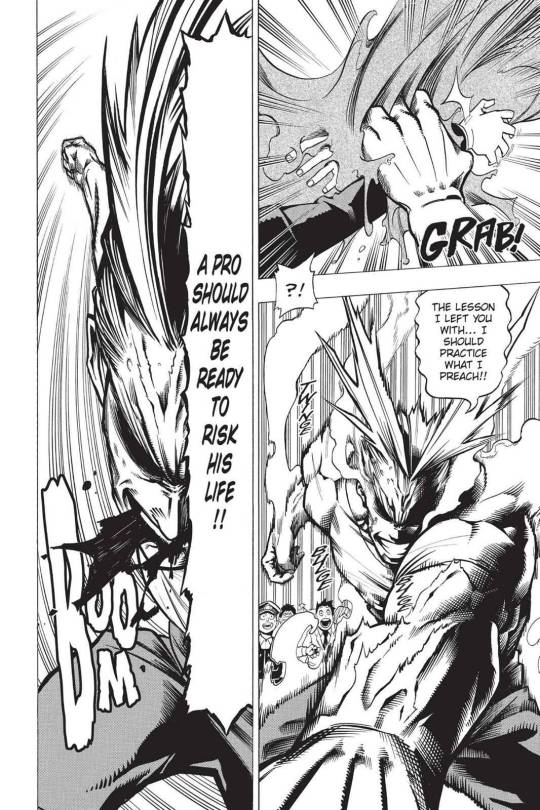
Heroes want to save, but some of them just don't know how--and Izuku teaches them how. Izuku teaches them that, for true heroes, to save others is more important than anything else they could ever want. It is more important than their self-perceived weaknesses, than their egos, than their desires for vengeance, than their small-time dreams, no matter how noble or justified or important any of those things might be. To be called a hero, one must be prepared to risk it all.

These are the traits Hero Killer Stain wishes to promote in society. These are the qualities he exonerates from assassination. A person who lives for the sake of "service to others" is the sort of person who has more right than anyone to "cling desperately to life." Society needs such people, and for that very reason such people need to stay alive. This is the collectivist ideal. If everyone is concerned for the well-being of others, then everyone is looking out for everyone else. If you're ready to save others and risk yourself to do so, others will risk themselves to make sure you make it out alive too, and thus everyone is protected. If you do end up perishing due to self-sacrifice, it is a tragedy, not self-determination, but then your actions still protected the whole, and the whole will continue to protect everyone in it to the best of their abilities because your self-sacrifice was appreciated and the spirit of your goodness carries on in others.
But that's a whole lot of waxing poetic about self-sacrifice. I did acknowledge that people are picking up a critical message. Where then is the criticism?
It comes from Shouta Aizawa.
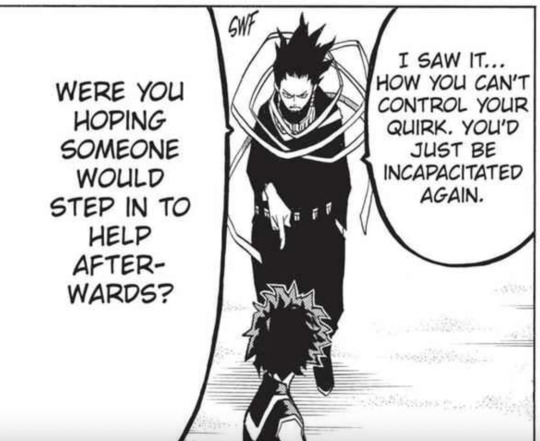
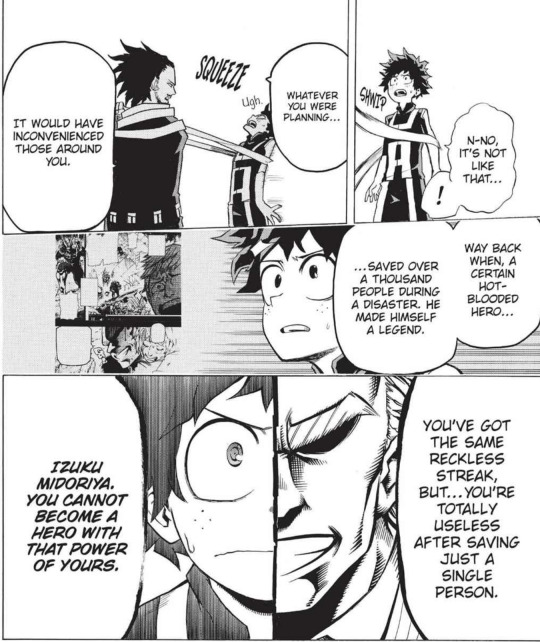
Aizawa is the major proponent of rationality in this case. Self-sacrifice = good is not the end of the philosophy. It is as you say, something must balance it out.
People often think Aizawa's philosophy boils down to "I don't want heroes to be self-sacrificial," but that's not actually what he's saying. Aizawa's philosophy is to make the distinction between self-sacrifice and self-destruction.
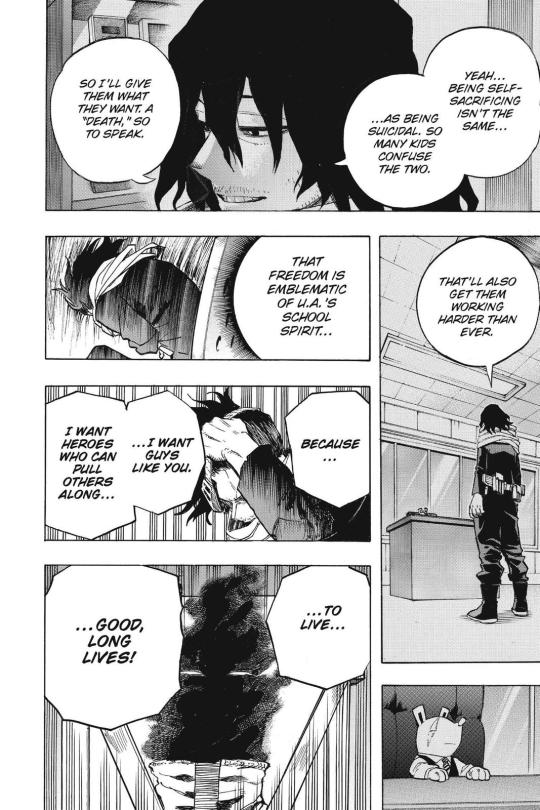
"Being self-sacrificing isn't the same...as being suicidal. Many kids confuse the two. So I'll give them what they want. A 'death,' so to speak."
The hallmark of heroic self-sacrifice is that it's done for the sake of others. Self-destruction is different; it is for the sake of the self. Some people would take the chance to mask their self-destruction as self-sacrifice by looking for a way to die while saving others. That's not the point of heroic self-sacrifice. Self-sacrifice is a last resort. You save a person in trouble because you care about preserving their well-being no matter the cost, but some sacrifices are not in balance. Say someone is trapped in a room and you want to get them out, and you have a battering ram and a bomb. Should you strap a bomb to your body and explode open that door to let the person out? Wouldn't that be a heroic sacrifice to save someone? No! It's certainly a sacrifice, but it's not a heroic one. You should act to preserve ALL well-being, including your own. Use the damn battering ram.
Consider the circumstances at play in the quirk assessment test. Izuku was ready to sacrifice his entire arm, his physical constitution, for the sake of demonstrating his power. What does Izuku incapacitating himself achieve were Aizawa to let him do so? It would merely be to prove his strength to someone. No one is at risk here. No one needs saving. Izuku has no person to receive the good will of his self-sacrifice.
"Whatever you were planning...it would have inconvenienced those around you."
"You're totally useless after saving just a single person."
Self-sacrifice is still a sacrifice, which means it has costs and consequences. Who loses because of self-sacrifice? Many people. The person who sacrifices themself loses their life or well-being, which, if others asking for help are worth saving because you believe all people are equal, then you are also worth saving and in just as much need of help. Additionally, your loved ones are harmed because they care about you. And the rest of society suffers because it was better for having you in it; you can no longer save anyone else. To save the most people possible, a hero should strive to survive. A hero should strive to win.

Taken all together, you get the philosophy that allows Katsuki's team to triumph during the Joint Training Arc, which was the entire point of this match. Note how all the above logic is summed up quite succinctly by the gremlin himself.

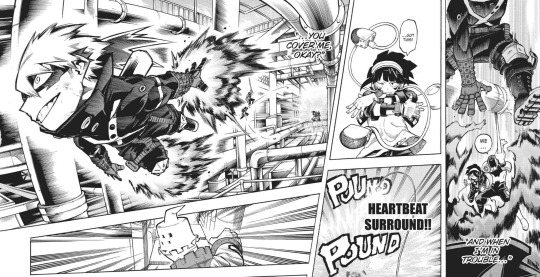
Katsuki is dedicated to winning the match and leads the charge, but that puts him at risk of being targeted. However, he's willing to be in that vulnerable state because he trusts others to save him. That's what empowers him to put himself on the line. His goal is a complete victory, which means that self-sacrifice is considered a loss. There are costs and consequences, and heroes should do their best to mitigate them. Katsuki is doing everything in his power to reduce the necessity of self-sacrifice, but not because he thinks self-sacrifice is bad. He thinks needless self-sacrifice is bad, and so he strives to eliminate the need for it.
But that means he does acknowledge that there are times self-sacrifice is necessary. He's grown up afraid of Izuku's heart because Izuku demonstrates how easily self-sacrifice comes to him, and that puts Katsuki on the spot. Katsuki doesn't know if he is capable of self-sacrifice. Because he's so competent and strong, he's never noticed a need for sacrifice in his life. He's never had to demonstrate self-sacrifice, and if that's such a fundamental part of being a hero, Katsuki doesn't know if he really is a hero at heart.
But as I mentioned above, the reason he never had a chance to display self-sacrifice as a trait is because he lacked the ability to tell when people need saving. He looks around and sees a bunch of people who are wasting their potential. He thinks some people who seem to ask for help are much more capable than they behave.

Note how Katsuki failed his hero license exam. If Katsuki had stuck around the triage center and fought Gang Orca when he showed up, Katsuki likely would have passed. But Katsuki decided to forego battle to run around and save people. And hilariously enough, the bystanders who dock Katsuki points point out that Katsuki correctly identified them as low-priority targets to save. He's pretty good at figuring out who DOESN'T need saving. They end up docking him points because of his inappropriate tone, which is possibly the funniest way they could have said "Well you're technically right but also holy crap you're bad at this."
And that's the point. Katsuki knows saving people is important, and he perceives Izuku is the absolute best at it. Katsuki is constantly looking for a way to compete with Izuku in this realm because he has to. Katsuki wants to be the best, and to do so he has to improve in this area. Izuku pisses him off because he is extremely adept at perceiving calls for help from those who truly need it, and Katsuki notices every time Izuku is faster on the uptake. It happens at the sports festival with Shouto, which is why Katsuki considers the sports festival a loss.
Katsuki does get better at this, and that's what allows him to eventually get his hero license. Think of his behavior during the school cultural festival, where he sees his classmates trying to appease their peers out of guilt. That's people pleasing. That's ego. Katsuki won't have any of it. From his perspective, if Class 1-A wants to make sure everyone has a good time, then everyone means everyone. Class 1-A has to enjoy the festival too, and the best way to do that is to throw a badass concert. By enjoying themselves and being proud of their well-earned accomplishments, by thriving, Class 1-A demonstrates to their peers how to best win against all those tragedies that tried to bring them down. Self-deprecation for the sake of appeasing others' ill will when that ill will is unjustified is just self-gratification. It's just a way to stop feeling guilty, but the only purpose that serves is to debase yourself. Class 1-A didn't do anything wrong to the other classes, so Class 1-A does not need to atone to them. Self-sacrifice in this case brings no benefit to anyone. Instead, the classes should all be thriving together.
All of these lessons converge in the Dark Deku arc. Others express worry for Izuku's behavior because they see him as engaging in self-destruction. They want him to rest, but Izuku perceives there are people in need of help, so he can't help but save them. And not everyone condemns Izuku's behavior.
Kudou encourages it.

The problem at play in this arc is the question of power. Izuku has power, which means he is capable of saving people. And many people are in need of saving. How many people can one finite Izuku save? That is the question he is set to answer. He is facing the same question as All Might, but All Might's example was to save people while he was losing One For All. All Might had a finite amount of power that he was going to lose in time, so he decided to spend that dwindling power on saving as many people as he could. That would be the more virtuous use of his finite power.
But All Might's flaw was in rejecting the help of others when others were capable of helping him. Izuku falls into the same trap. He thinks he has to save people alone because he's the only one capable of it.
This is Kudou's spoken caveat. "Inaction is not an option," so yes Izuku needs to be acting in this moment. "That said...if there's anything that could bolster Izuku Midoriya now, it would be..."


The answer is not merely "friends." We are given the answer that Izuku needs friends at first, but this is a special type of friend. Izuku needs friends who "share his resolve," who "can match his pace...and keep running alongside him." Izuku needs comrades (nakama)! He needs friends who want to save just as much as he does. He needs friends who are just as capable as he is. That's why Class 1-A has to first demonstrate their capabilities to Izuku so that he can be convinced.
Katsuki doesn't criticize Izuku's ideals either. In fact, he openly praises them.
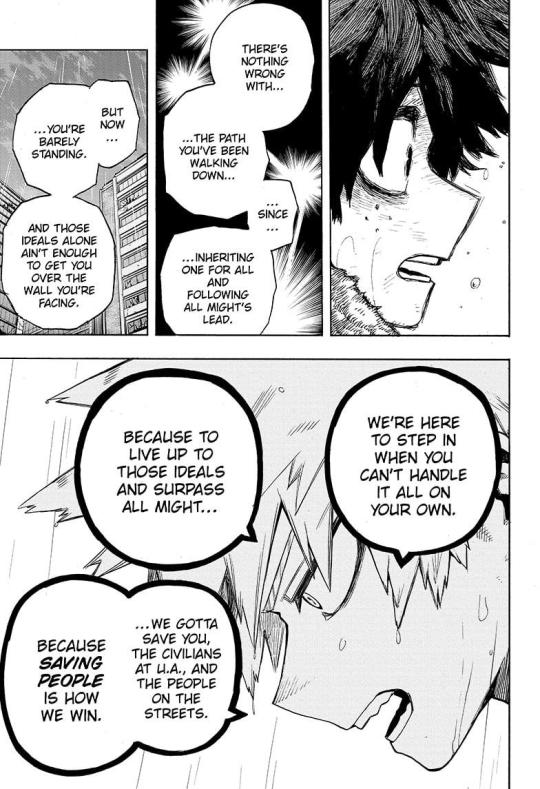
All Katsuki is saying here is "You're doing the right thing. Saving people, even at cost to yourself, is the right thing. We want to help. We can help. Don't reject us.
"Don't pay a price when you don't have to."
tl;dr
In a collectivist society, the ideal is that everyone looks out for each other, thus is everyone protected.
Self-sacrifice has costs to the self, to one's loved ones, and to society. The price paid must be worth the good achieved.
The virtue in self-sacrifice is that it is done when necessary for the sake of others. Anything less is self-destruction, which is harmful to society.
Heroes have a duty both to be prepared to self-sacrifice and to mitigate the need for self-sacrifice.
Rejecting the help of others who are capable of helping is to reject the collectivist ideal.
Izuku's self-sacrifice is virtuous BECAUSE IT IS FOR OTHERS' SAKES. Izuku's self-destruction and rejection of help from others are what the story criticizes.
Izuku Midoriya's nature represents the ideal of self-sacrifice because of his innate desire to save others, and Katsuki Bakugou recognizes that trait as core to being a hero and thus admires Izuku for it--but he's also afraid he doesn't have that trait for a large chunk of the story. Izuku's journey to accepting the help of others, Katsuki's journey to discovering his self-sacrificing spirit, and their mutual admiration of each other all provide the perspective for the audience to understand this ideal: heroes are those who live in service of others.
#pack it in everybody#pika's fucking done it#this is the message#THIS IS THE CORE#you cannot ignore Katsuki's side of the story because he and Izuku are two halves of this singular message#they complete each other#they each lacked what they valued in the other#together they are the greatest heroes#but more than that#everyone else also become better heroes from their admiration#people need each other#we need to look outside ourselves and see value in others#we need to want to emulate the goodness we see outside ourselves#Horikoshi is not criticizing collectivism as a social system itself#he criticizes the way people have FAILED within the system#through prejudice or apathy or arrogance or insecurity or selfishness#when you sacrifice yourself needlessly supposedly in service of the collective#you are harming the collective#because you are PART OF IT#ugh this post is so good#I am rolling around in it#I would say I'm sorry for reblogging everything pika posts BUT I'M NOT#the pika special#not my meta
220 notes
·
View notes
Text
I just need everyone to understand the reason I know Izuku's self-sacrificial traits are not condemned by the MHA narrative is BECAUSE Katsuki admires them. Katsuki is NOT slowly coming to fear Izuku's self-sacrificial nature over the course of the story and growing protective of him for it; Katsuki's coming to the realization that those self-sacrificial traits are what he was always awed by and afraid of. It's the way Izuku is--and that's what Katsuki wants to be like.
That's why he felt like he lost at the sports festival, because Izuku's self-sacrificial nature achieved the most heroic outcome (Izuku sacrifices his pride and the advancement of his hero dream to make Shouto into a better hero than he ever would've been if Izuku had not saved him), and Katsuki could not match that AND HE KNOWS IT.
That's also why he saves Izuku in the Paranormal Liberation War, because he recognizes what an amazing hero Izuku can become and in the process learns to express that same self-sacrificial trait he never knew he had. He's protective of Izuku's dream, the ideal Izuku represents. The whole "One For All may be a cursed power, but--" line was probably meant to end with "but it's his power, it's allowing him to be a hero, it's allowing him to have his dream." IT'S AN EXPRESSION OF HIS ADMIRATION OF IZUKU'S HEROISM AND HIS DESIRE TO KEEP IT ALIVE.
I just need everyone to knowwww.
#listen to me#katsuki wants to fight ALONGSIDE izuku#he does not want izuku to stop being a hero#or stop putting himself in harm's way#he wants to be strong enough to be by his side#he wants to be an ASSET#not a liability#izuku is his fucking ideal#and what could he want more than to be able to stand beside his ideal#OR#SURPASS HIM#because driving one another to be better is the lifeblood of their bond#to surpass his ideal hero#to be the one running ahead#looking back saying#try and catch me now#just so he can watch izuku level up all over again#marvel at it#and earn himself a new fucking challenge#katsuki has always seen izuku's value#he has always admired him more than anyone else#he is able to save to win because of this admiration#the narrative does not condemn self-sacrifice#it condemns careless over-eager arrogant self-aggrandizing self-destruction cosplaying as a self-sacrifice#the pika special#not my meta
280 notes
·
View notes
Text
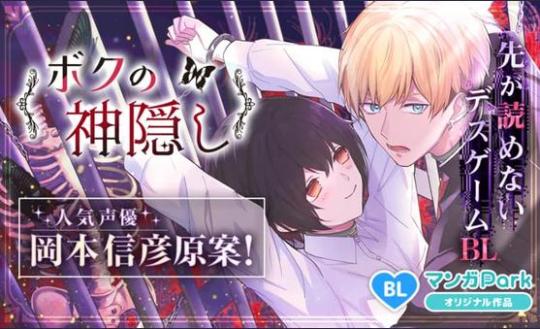
Time for a lighthearted review!
By now a number of people have heard of ボクの神隠し(boku no kamikakushi), aka “My Spiriting Away” or “My Mysterious Disappearance,” aka the BL manga that Okamoto Nobuhito, voice actor of Bakugou Katsuki, was involved in. It is available to read for free in Japanese here with a total of three chapters. This post contains spoilers for the ending.
Here’s a Q&A peppered with my thoughts on it.
The Premise
Crybaby Uzuki idolizes his childhood friend Haruto who always protected him, but since they started high school, their relationship has soured, leaving Uzuki utterly alone. One day, the pair are kidnapped by a strange man and forced to participate in a mysterious game of life-or-death.
How is Okamoto involved?
Okamoto is credited for the 原案 (gen’an). A corollary industry term in English would be “original idea” or possibly “scenario.” In my experience with comics, this suggests he created the characters and premise, then wrote the concept out and submitted it to a second party to be fleshed out for full production.
The script is credited to Production Beijyu (プロダクションベイジュ), a company who offers a variety of production and promotion services with a focus on editing and proofreading books, magazines, manga, and anime.
The manga—so the artwork and all of its production—is credited to 戸真伊まい, a name I can only guess is read as Tomai Mai, which sure sounds like a pen name and doesn’t appear to be linked to any other published work. This could be for a lot of reasons; the artist might be totally new or they might have worked in other genres and chose a unique pen-name for BL, but the only thing I found attached to this name online was their Twitter account.
How’d it get made, anyway?
As far as I can tell, Okamoto must have personally reached out to Beijyu and applied for their services to help make his idea a real thing. Beijyu gear themselves towards small, independent artists and authors, especially those who haven’t debuted with a magazine or printed publication yet.
For those unaware, manga is a massive industry in Japan, and it can be extremely difficult to get your foot in the door. Many creators talk about having their concepts rejected repeatedly by magazine after magazine, or getting a single one-shot published and then struggling to keep the momentum. There’s a reason all of the huge Shounen Jump creators talk about the intense pressure to keep their work popular and to avoid getting dropped from publication by any means necessary.
Boku no Kamikakushi is available for free and I haven’t heard of any plans for a physical release. To be honest, this suggests to me that Okamoto genuinely wanted to get his story made regardless of profitability—he isn’t just a celebrity attaching his name to a series for attention. There wasn’t some industry demand or opportunity that he took advantage of for professional gain, he must have been the one to initiate this endeavor, and honestly, good for him.
Is it really bkdk?
Nah. I will grant you that the tropes at play certainly reveal Okamoto’s tastes, and we sure could extrapolate about his feelings on bkdk from those tastes. But beyond the similarities in backstory, base themes, and design aesthetic that people have pointed out, the couple have very little in common with bkdk, and in fact, the way they diverge is kind of hilariously shocking??
Okay, fine. What’s their deal, then?
Uzuki is a yandere rich boy who likes to get choked. Haruto is honestly a hapless, horny victim in all this.
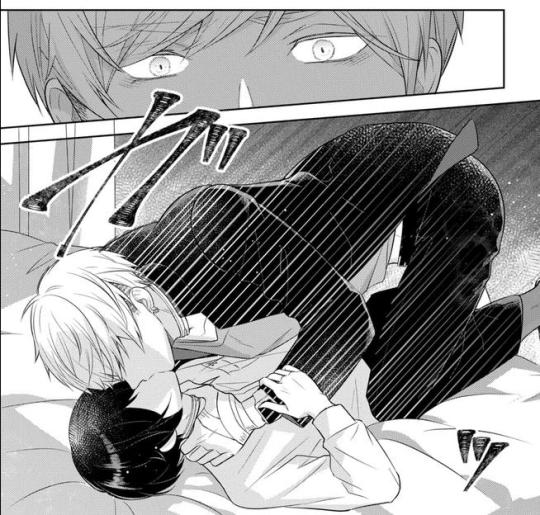
What!?
Yeah. The “mastermind” behind the kidnapping is Uzuki himself, who staged the whole thing with his butler. Basically, their high school classmates tease Haruto for being associated with Uzuki, the son of the richest noble in town; Haruto resents it so he distances himself from Uzuki and rejects him. Uzuki ends up lonely with no friends and missing Haruto, so he stages his own kidnapping and puts them both in the “death game” as a way to force Haruto to remember his childhood promise to protect Uzuki as his hero.
That’s insane???
YES. IT IS ABSOLUTELY INSANE.
It’s especially funny because the parameters of the death game don’t technically require them to have sex or get intimate, Uzuki is just a fucking freak and Haruto is confused by his own horniness and goes along with it. The first trial involves a selection of drinks, one of which contains poison, and they have to keep choosing one to drink from until someone dies. Haruto ends up poisoned, and Uzuki uses his prize (“one wish”) as the winner to get the antidote and save him, of course passing it to Haruto via full-on mouth kiss.
Haruto has a gay crisis about it.
The second game: whoever raises the other person’s heart rate to 130 beats per minute first wins, and the person with the elevated heart rate dies. Haruto’s heart rate spikes from aftereffects of the poison, and Uzuki’s solution is… for Haruto to choke him… on the bed they woke up on… so his heart rate increases as well. And then he asks Haruto to kiss him, too, and they just start making out until Uzuki’s heart rate hits 130. Haruto gets upset because he lost his head and ended up dooming Uzuki, but then somehow they arrange for this death to also be nullified, and they end up continuing to play the game for three days.
Three whole days!?!
THREE DAYS! This kid traps Haruto in a dungeon so he can make him participate in weird, sadistic, horny shenanigans for three days!
And then when they finally escape and everything is revealed, Haruto is just blankly confused and has this absent look on his face, repeating that he’ll protect Uzuki. The butler says that Uzuki performed excellent mind control, but then Uzuki imprisons the butler so it can be “just the two of them.”

What the fuck, Okamoto???
Right? And you know what, it isn’t my jam at all, but can we just take a moment to recognize that a professional voice actor who is popular and prominent in the public eye wanted his weird horny BL idea to come to fruition, so he went forth into the world and made it so? And he didn’t even hide behind a pen name or anything, he wants people to associate him with it, he’s promoting it! He loves the hell out of it!
Like, I’m pretty astounded by that, and honestly I respect it. More people should just make things that cater to their own tastes without any self-consciousness about it. Wave your freak flag high, Okamoto.
#boku no kamikakushi#bakuhatsu silly reviews#this is THOROUGHLY unrelated to mha#but I thought it'd be fun so here we are#also there are some typographical choices unique to small press and online comics that I find super interesting#for example how Uzuki uses the pronoun boku EXCLUSIVELY in katakana#while Haruto uses the standard kanji for his pronoun ore#and the characters' names are only in katakana not kanji or hiragana#and you even see little internet slang like ww for laughing#I'm just here dissecting minute choices in how Japanese is written#don't mind me#anyway proud of okamoto for revealing himself to be a total weirdo#just like the rest of us#hope this post was elucidating for everybody lmaooo#now back to your regularly scheduled programming
26 notes
·
View notes